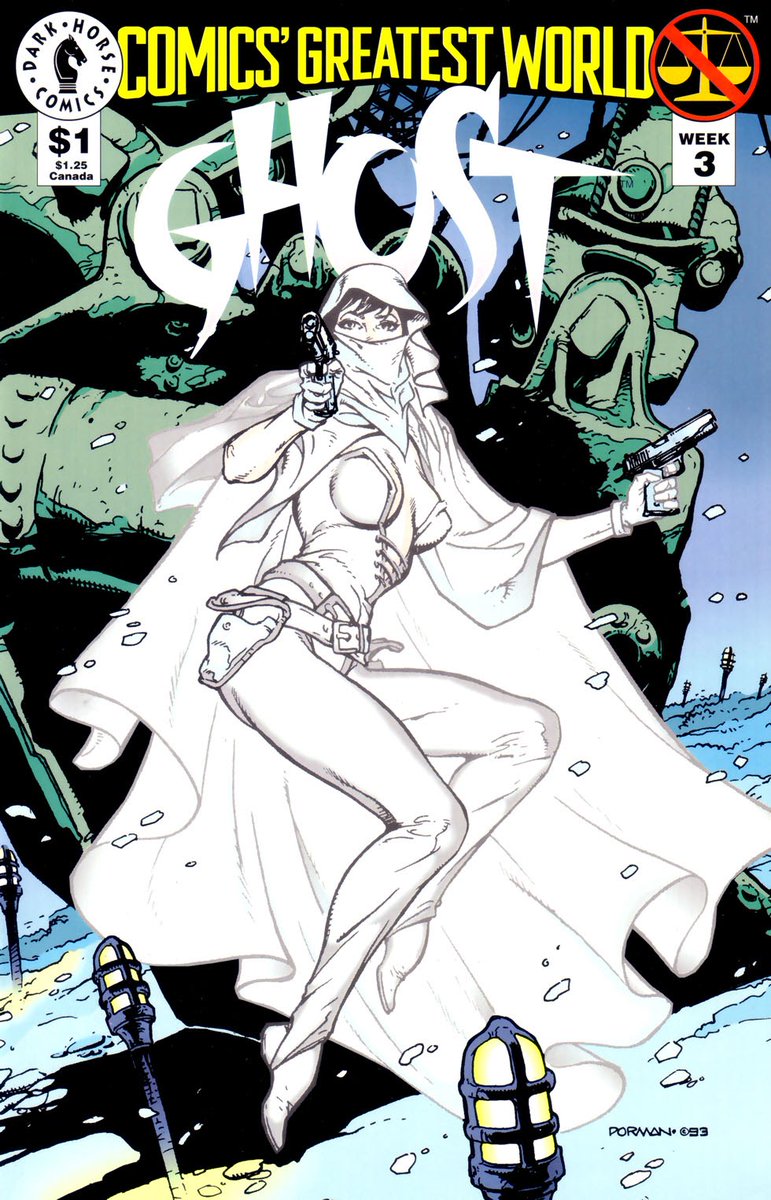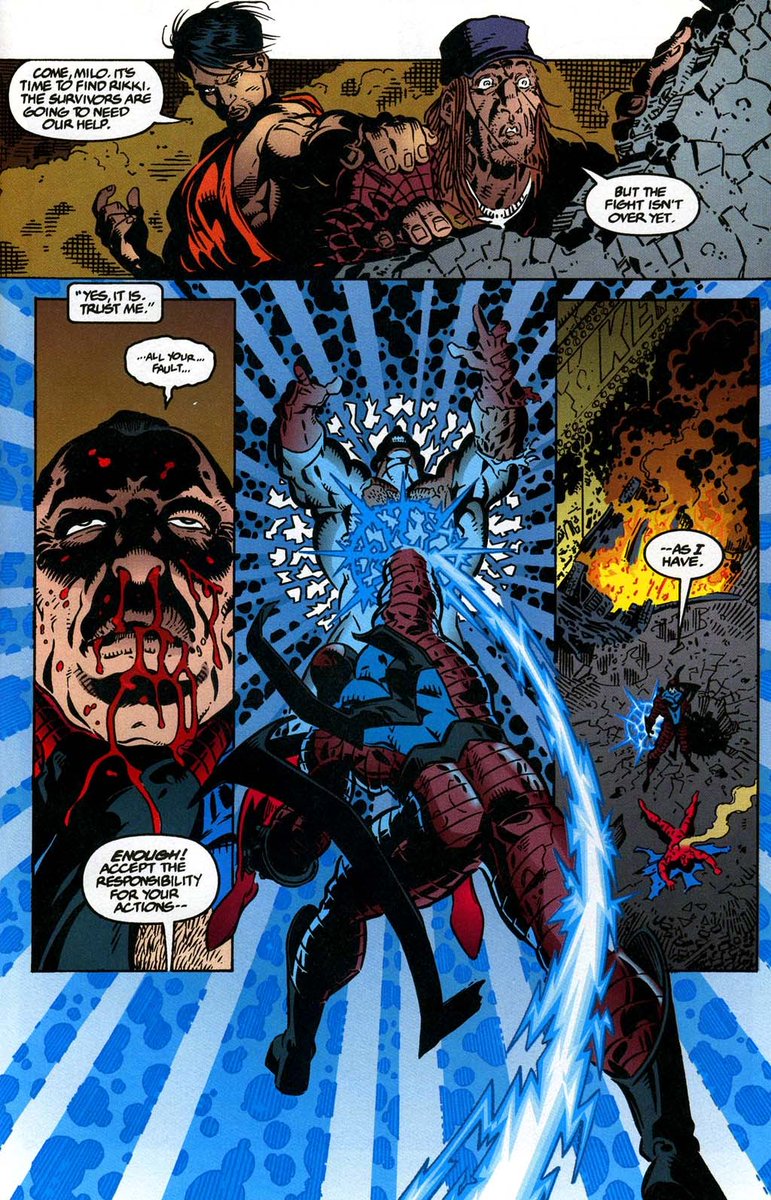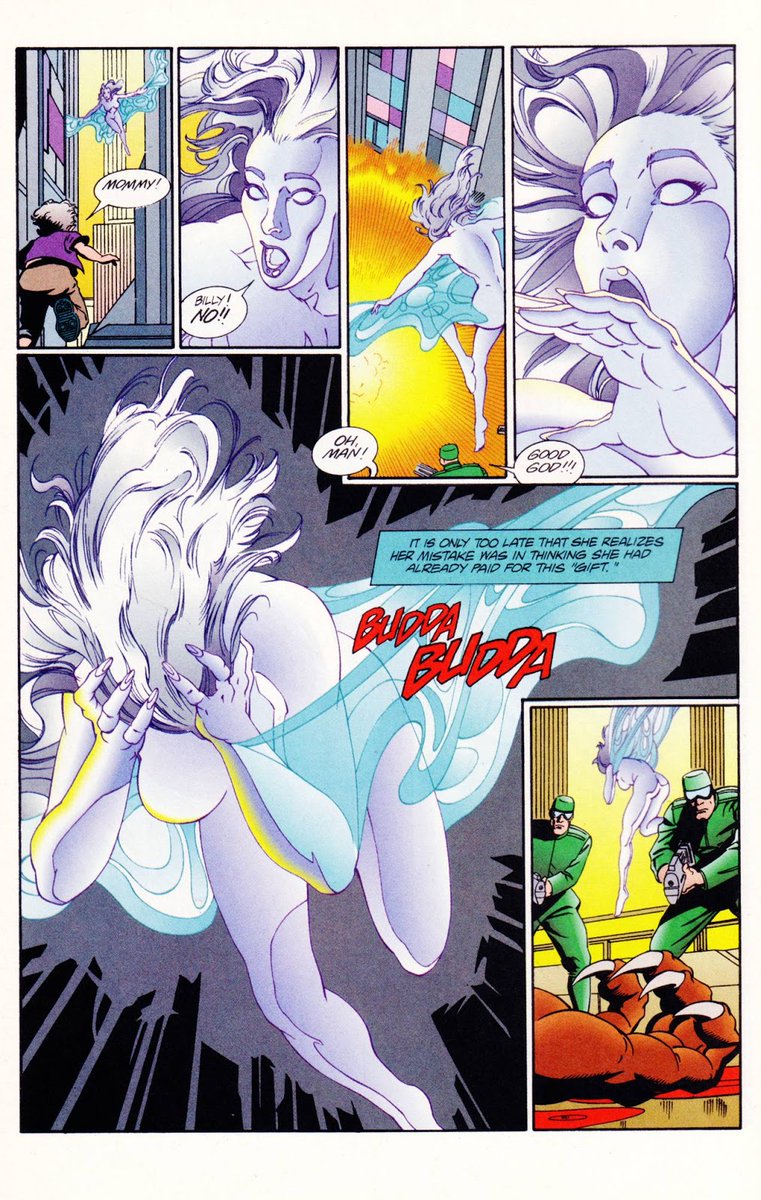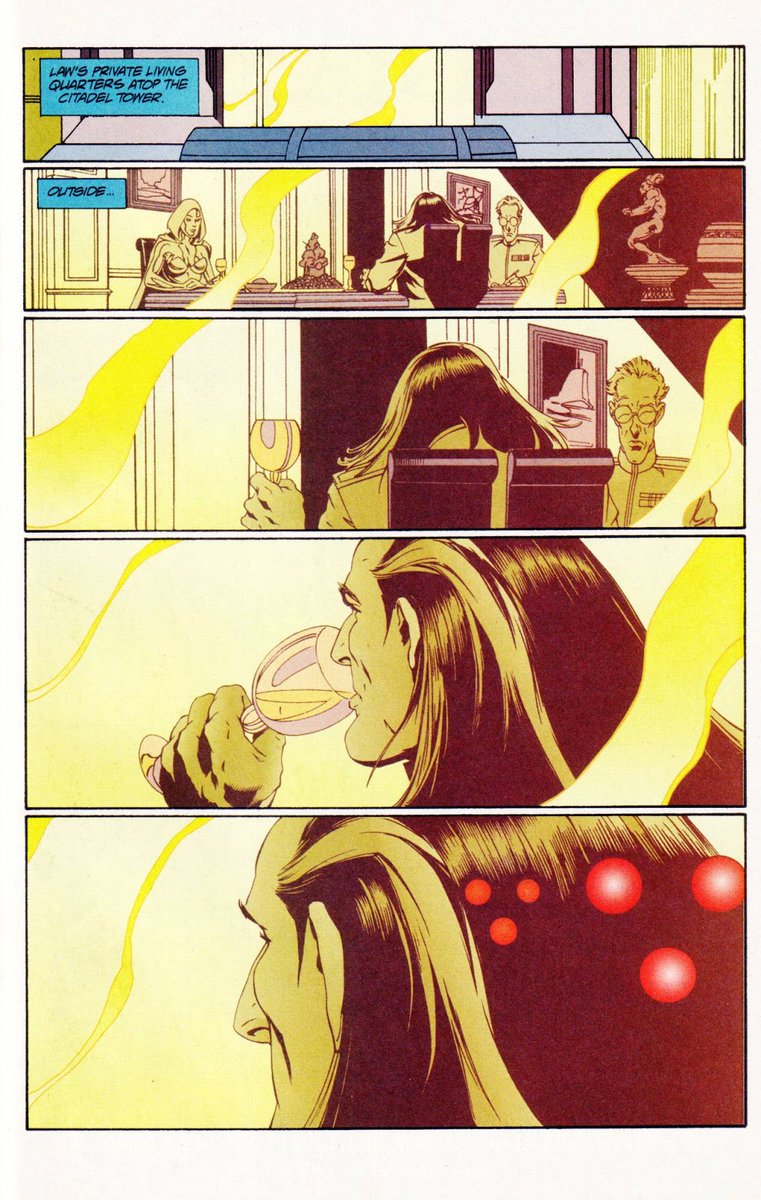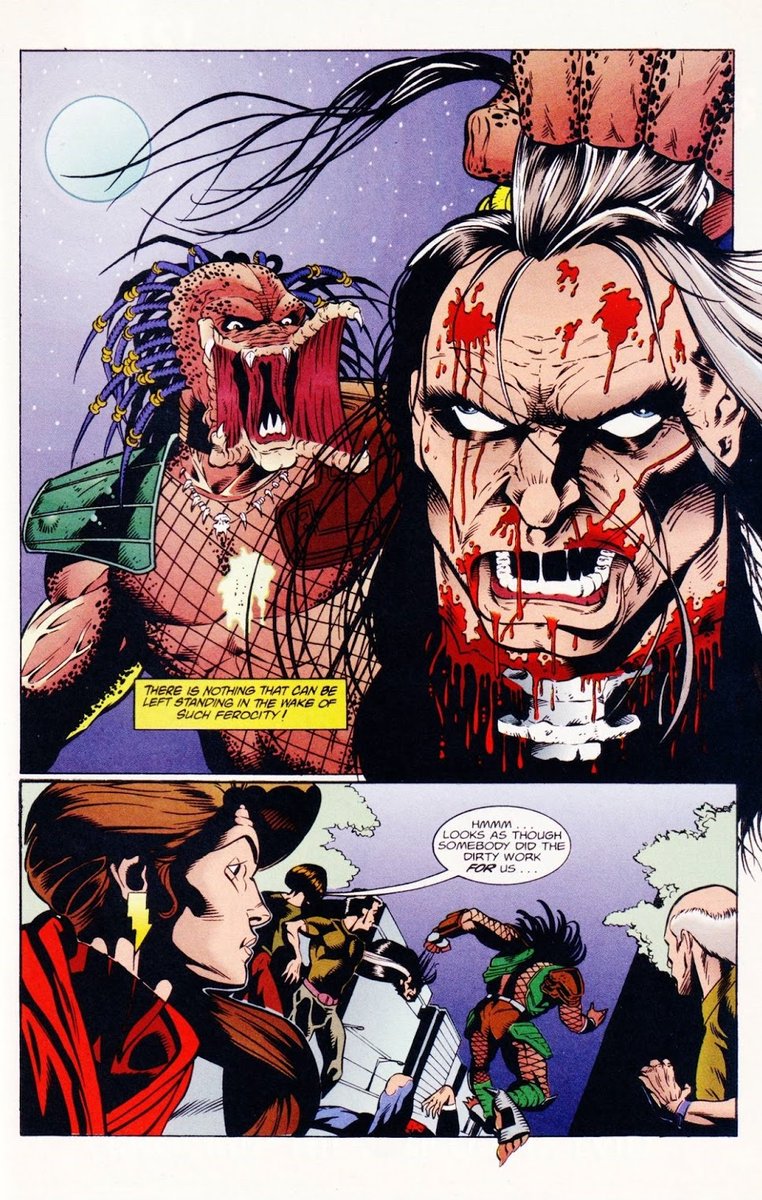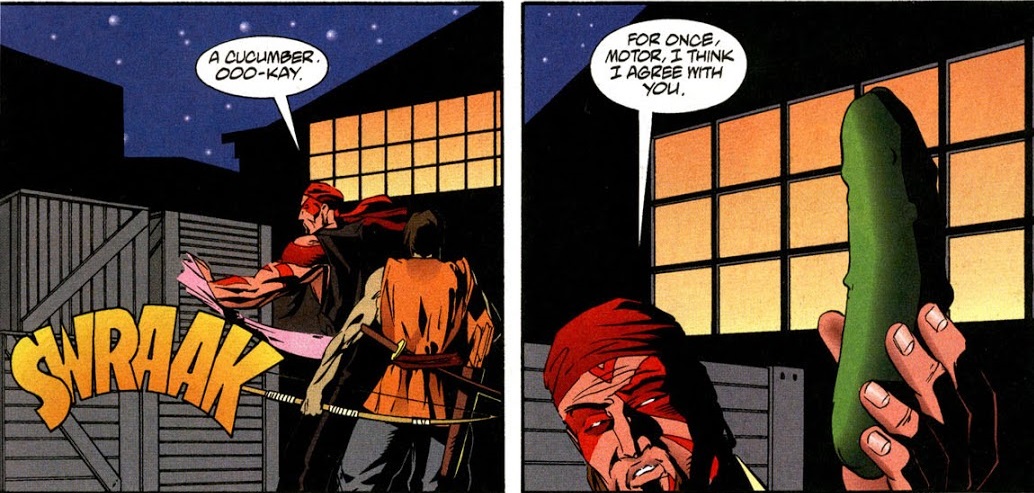Put on your flannel shirts, denim pants with suspenders and backwards baseball caps because we are once more going back to 1993 to visit a publisher I have yet to explore - Dark Horse! Today I'm talking about their FIRST foray into superhero comics - Comic's Greatest World! 
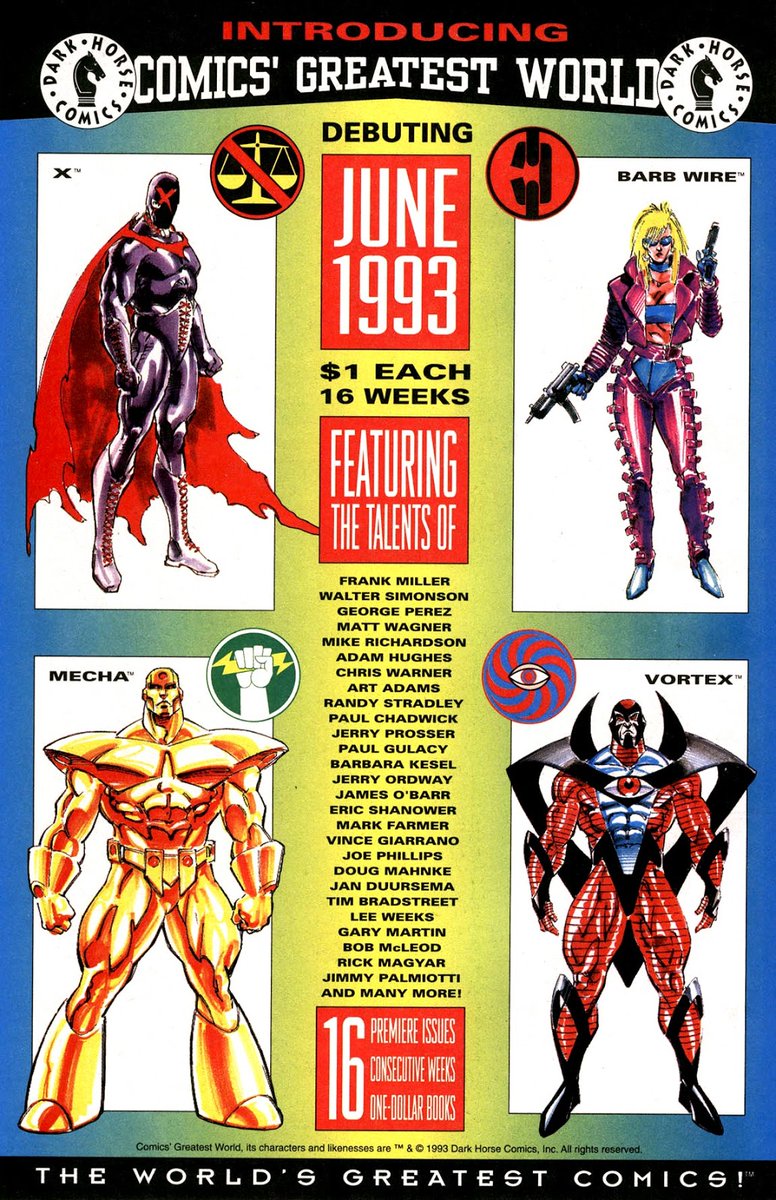
This was partially motivated by the rather dire news about Dark Horse which sadly is not surprising. It's a company which I personally have a long history with and it is a shame to see them fall on hard times, even if some of it is due to unfortunate factors. 

Before we dive into the speculator-frenzied years of the 90s we must first set the scene. Dark Horse was founded by Mike Richardson in 1986 in Milwaukie where Richardson had operated a comic book shop. 

One of his earlier recruits was Randy Stradley who both edited, wrote and plotted many books for the company over the years. 

The very first comics from Dark Horse were riding the indie wave in the second half of the 1980s with the most important being Dark Horse Presents, an anthology which presented a plethora of different features. 
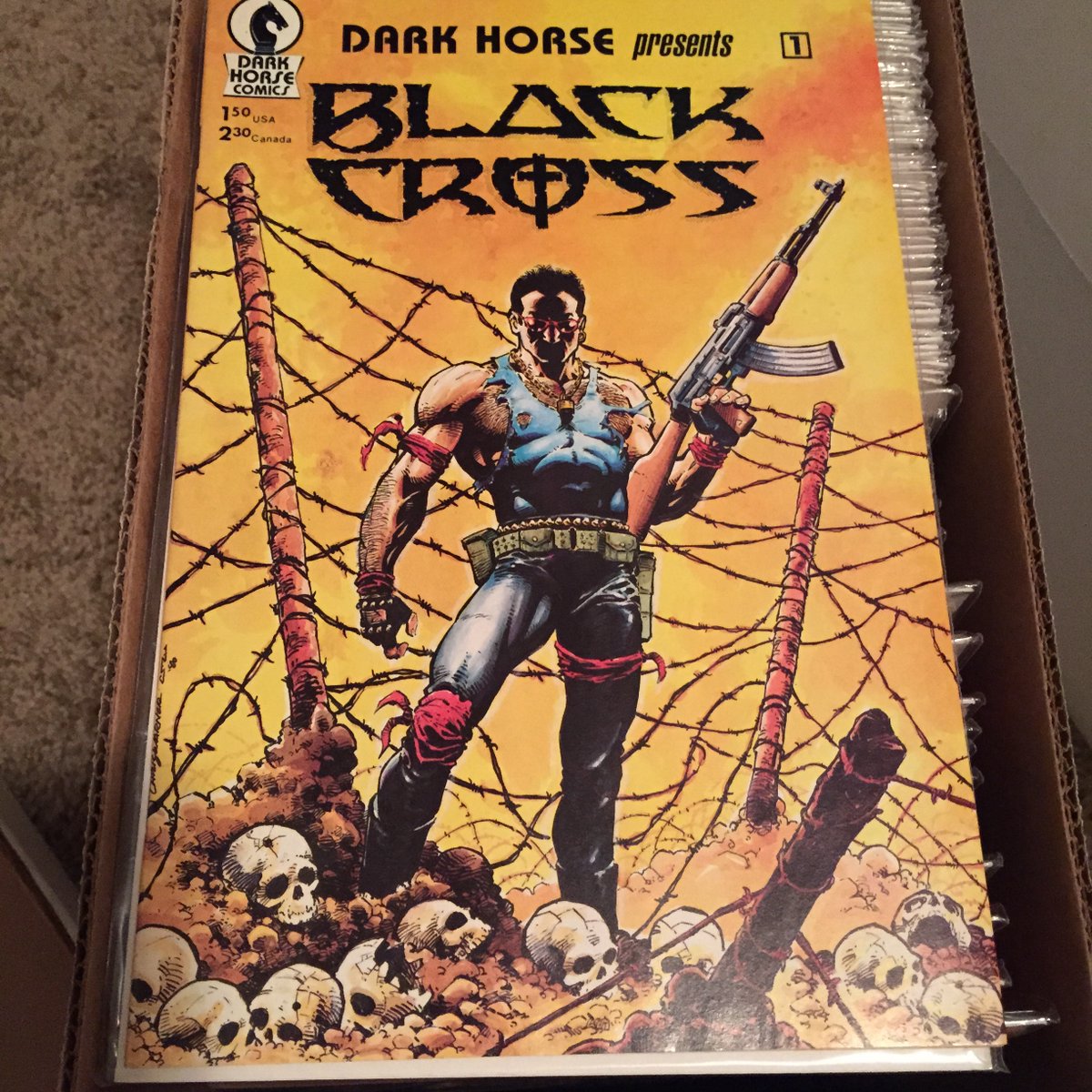
The other comic in the opening lineup was Boris the Bear, a cynical, violent commentary on then-current trends in the comics market (and beyond). That tagline is indicative of the title, I'll say. 
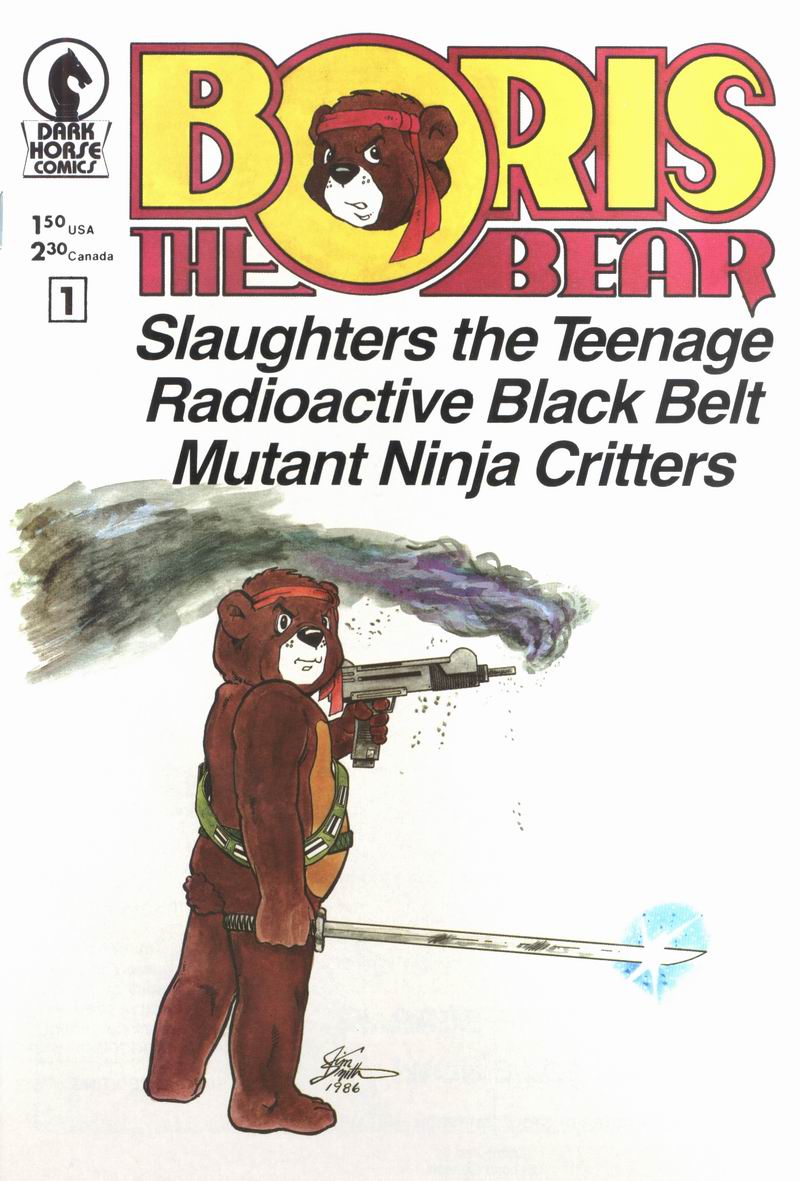
...and The Mask, a feature which went through some major overhauls and creative team changes before settling on the familiar story. The movie was of course quite a way into the future at this point. 
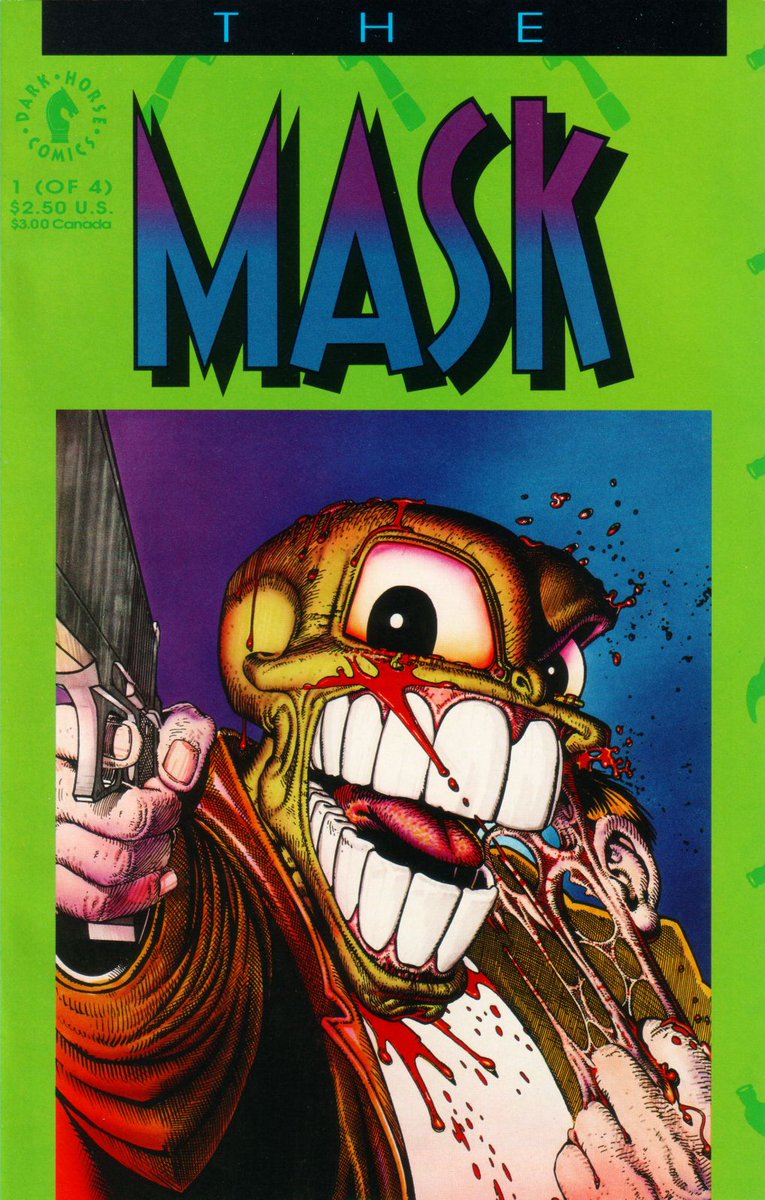
Before we fast-forward to the 90s I just want to note that in 1987 Stradley along with artists Harrison Fong and Art Nichols released a title called "Mecha" about the pilot of a gold-colored mech inspired by anime and manga. This concept would come back in a very different form! 

Around 1990 Richardson and the Dark Horse staff began discussing releasing a superhero comic, but as they perceived the market unfavorable for it the project kept being delayed. This didn't change until the explosion of comics publishers in 1991-92. 
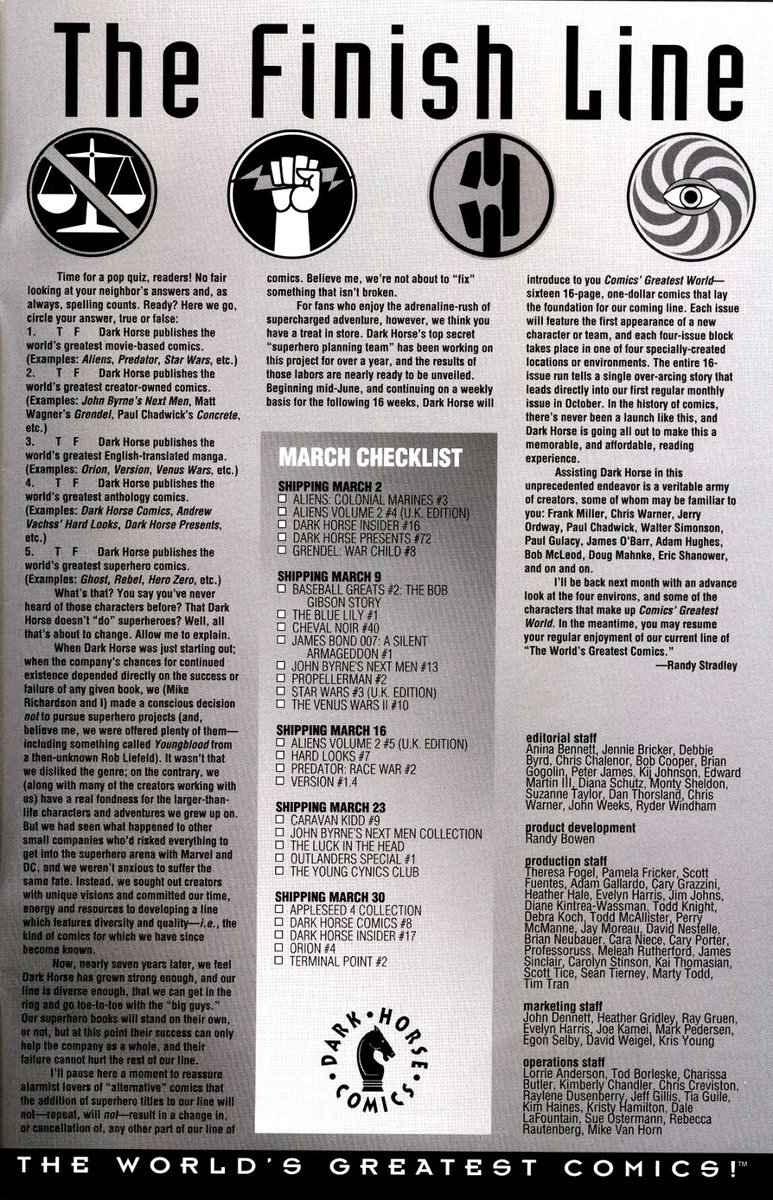
By this point Dark Horse had accumulated many popular licensed comics such as the Aliens/Predator and Star Wars franchises as well as creator-owned successes like Grendel. The company seemed ripe for expansion into the post-Image explosion, and plans were drawn. 
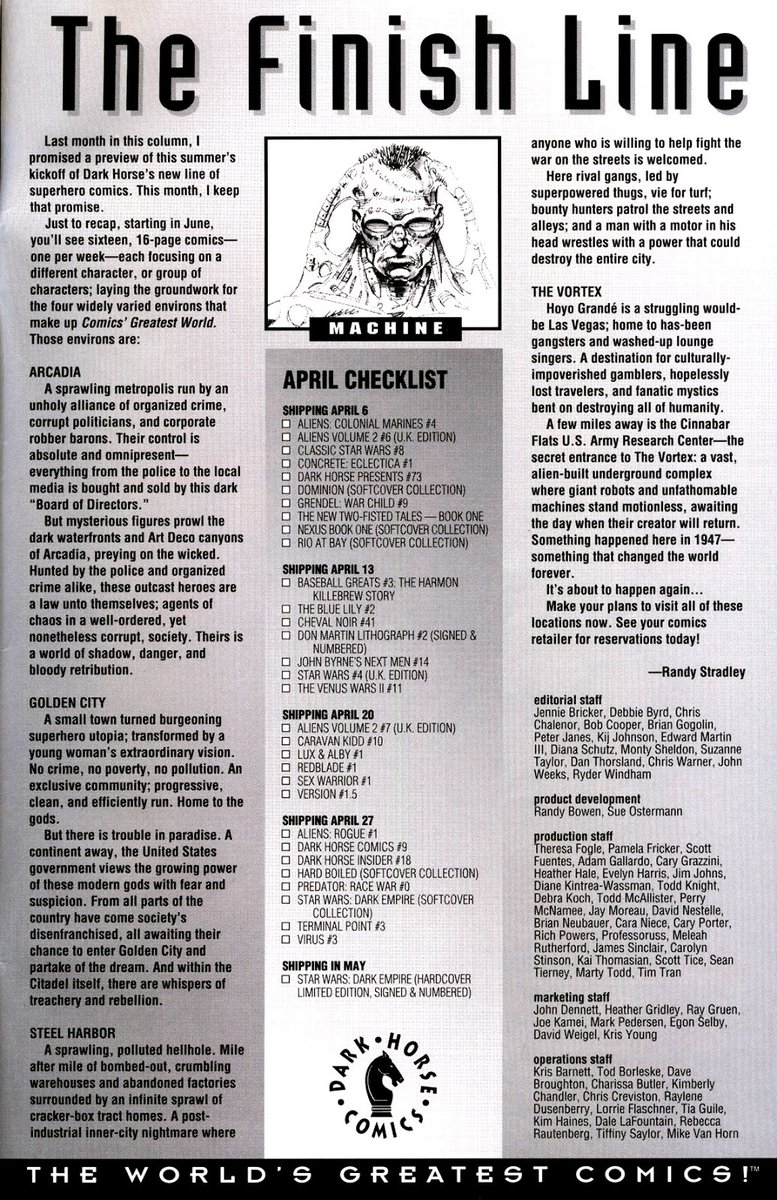
Dark Horse chose a different approach to their worldbuilding than that used by for example Malibu and Image. Their universe would consist of four "families" of books, each taking place in a fictional american city. 

Barbara Kesel revealed that one of the reasons for this was that this meant the creative teams could do whatever they wanted to the cities - blow them up, alter them fundamentally and whatever else! Each city had its own editor and its own distinct feel. 
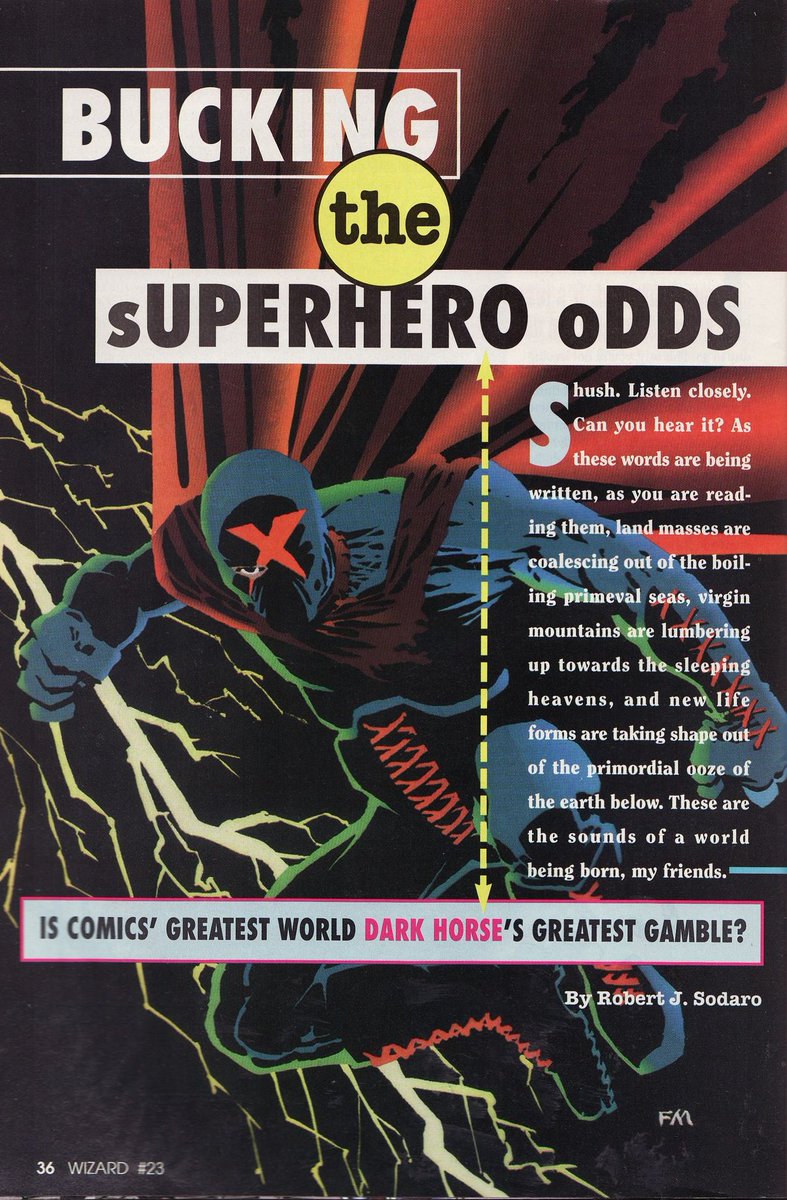
And so in early 1993 after lots of advertising and hype in comics journals Dark Horse introduced their new setting in Dark Horse Comics #8, the first of a three-part story called... "Who is X?" 
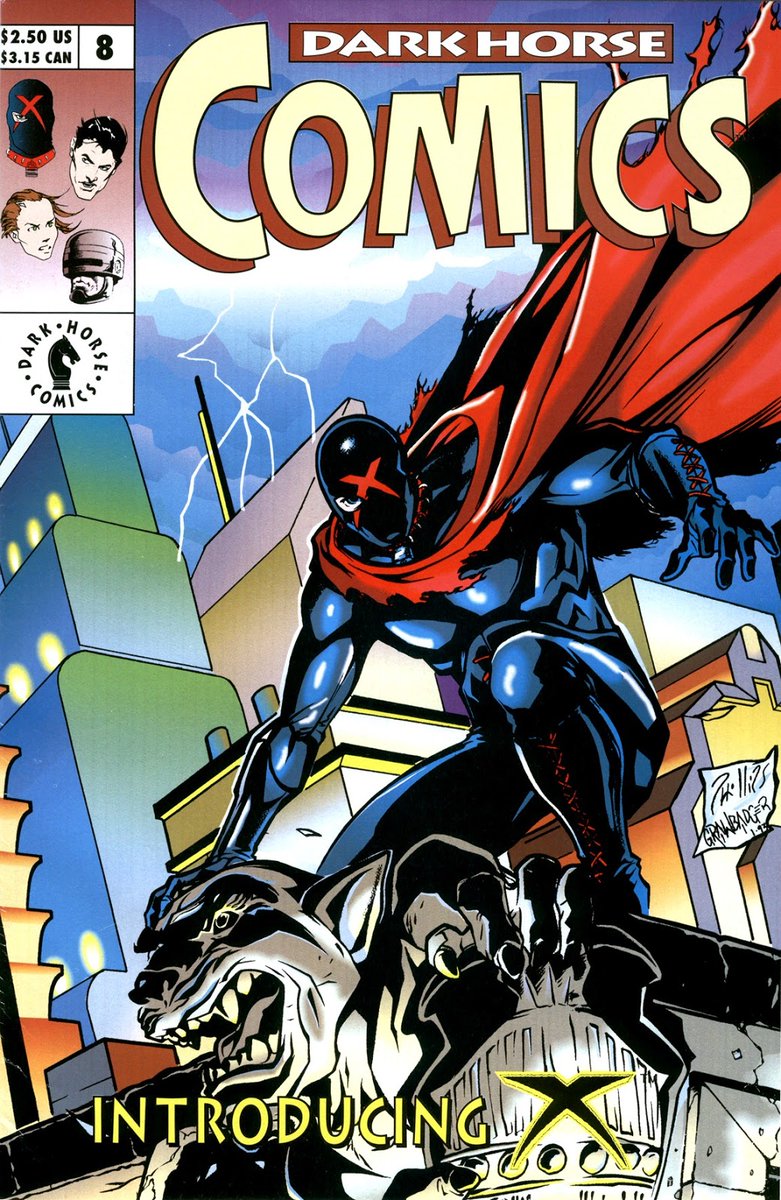
Typically of Dark Horse, X shared his debut comic with Robocop, James Bond and a Star Wars feature, but this would quickly change! 

From the very first strip it seemed that the Dark Horse superheroes would be a little less flashy and a little more gritty than many of their competitors. X was a violent vigilante using very regular firearms to mow down those he felt had crossed the line of his home city Arcadia 
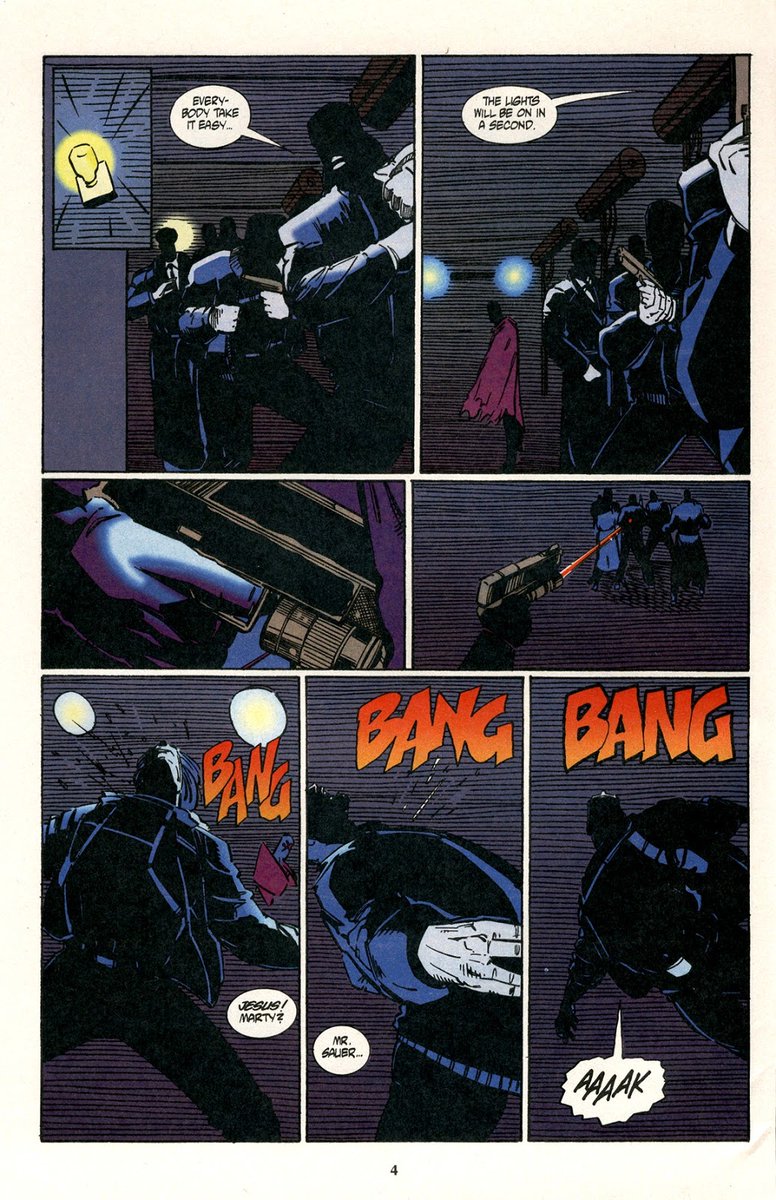
Following the three-parter the setting as a whole was introduced through four mini-series, each set in one of the cities and all interlinked through some mysterious aliens who went around cataloguing superhuman activity. 

It should be noted that this 16-issue series was released weekly, with each issue costing only $1 (a steal even then) and often featured very heavy artistic names either doing covers or interiors, but no other real gimmicks of the era.
The first issue was fittingly enough X, set in Arcadia. Arcadia is essentially the setting's Gotham, a hugely corrupt city run by crooked politicians, businessmen and gansters. 

The issue actually starts exactly where the 3-parter left off, with X jumping out of the window of the crooked politician he just killed. Gorgeous art by Chris Warner and Tim Bradstreet too. 
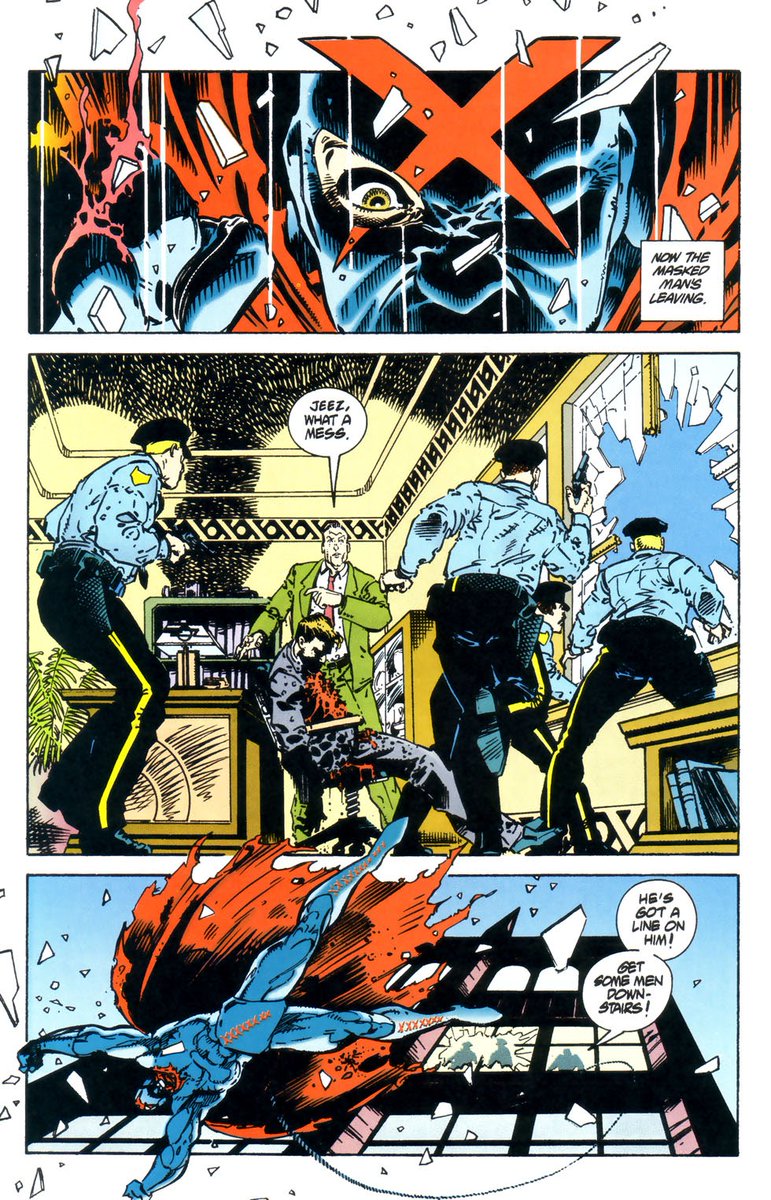
X continues showing his brutal methods as he is hunted by the police and observed by the invisible aliens. A cool start to the setting for sure. 

Not every feature in the introduction was a winner to me and one of the ones that is most forgettable was week 2's Pit Bulls, also written by Jerry Prosser with art by Joe Phillips and John Dell. A strike team trained to be attack dogs, they never stuck with me at all. 

Despite their ferocity the Pit Bulls are also unable to apprehend X, who escapes. Yeah I don't think these guys are gonna last either. 

While X is shaking down another crooked politician, a mysterious ghostly figure appears and demands X release the man to her. 

Ghost absolutely PUNKS X and then spooks the observing alien who is unable to hurt her and can be hurt by her in return. Quite a debut! 

Unfortunately for Ghost, X is a sore loser and the informant is toast. This is their first but far from their last meeting. Adam Hughes and Mark Farmer providing gorgeous art too. 

Week 4 introduces the Monster, a feared Hulk-like creature lurking beneath Arcadia's surface who is nonetheless intelligent. He clashes with X and one of the mysterious aliens ends up being killed. 
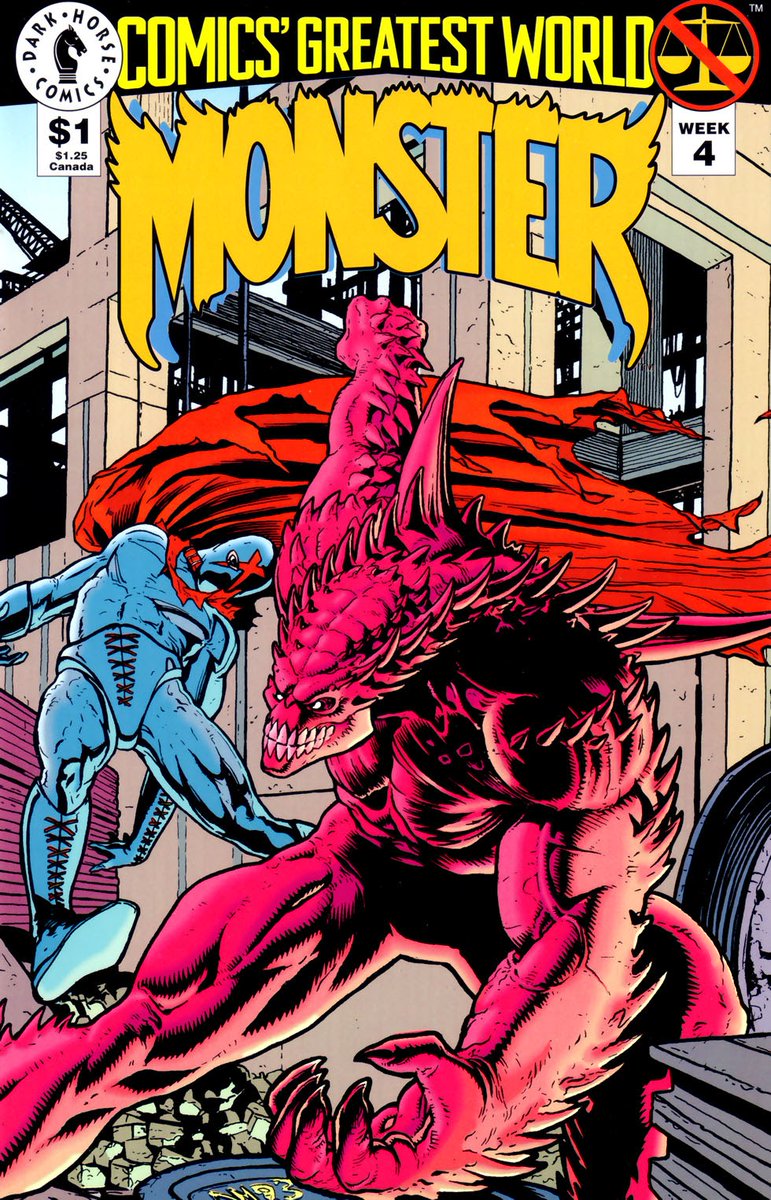
Next up is Golden City and- OH MY LORD NO REBEL WHAT ARE YOU WEARING? This cannot possibly have looked cool even in 1993, man! And the mullet does you NO favors! Not even Jerry Ordway can save this! 
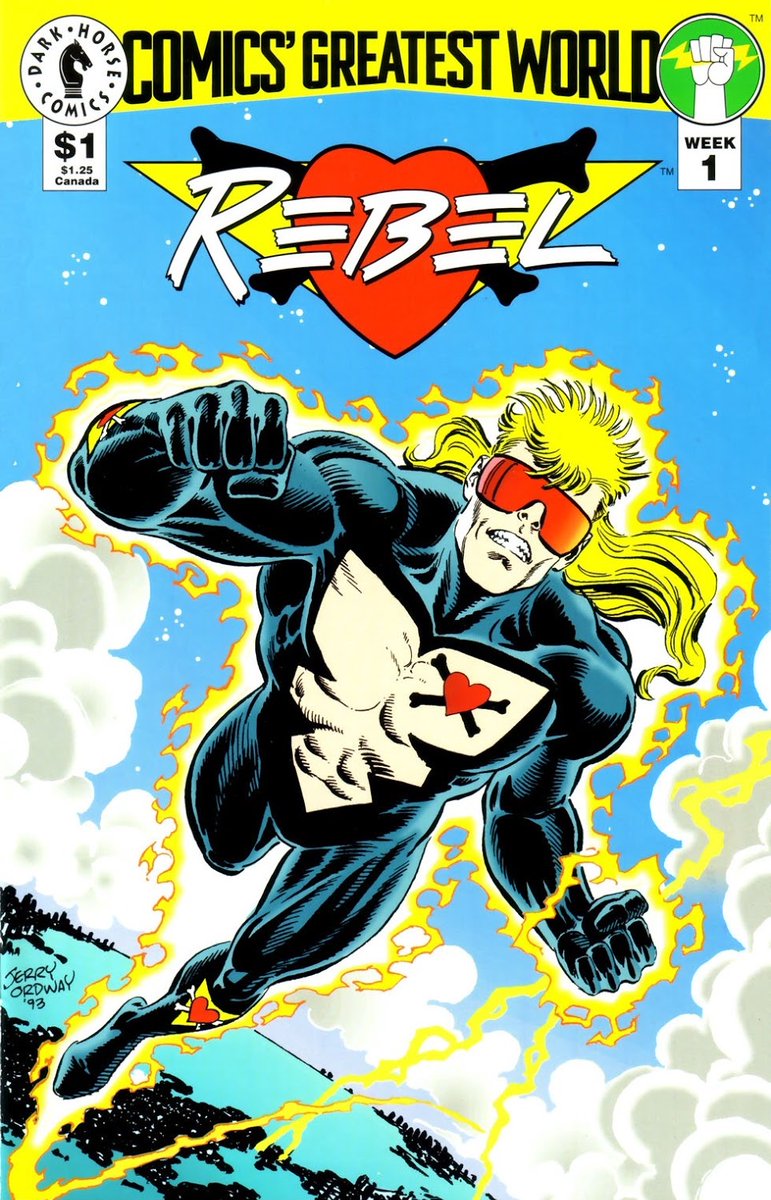
Golden City is the true opposite of Arcadia - a gleaming utopia with a high living standard, ruled by the mysterious but benevolent Grace who has vast physical and teleportation powers. 
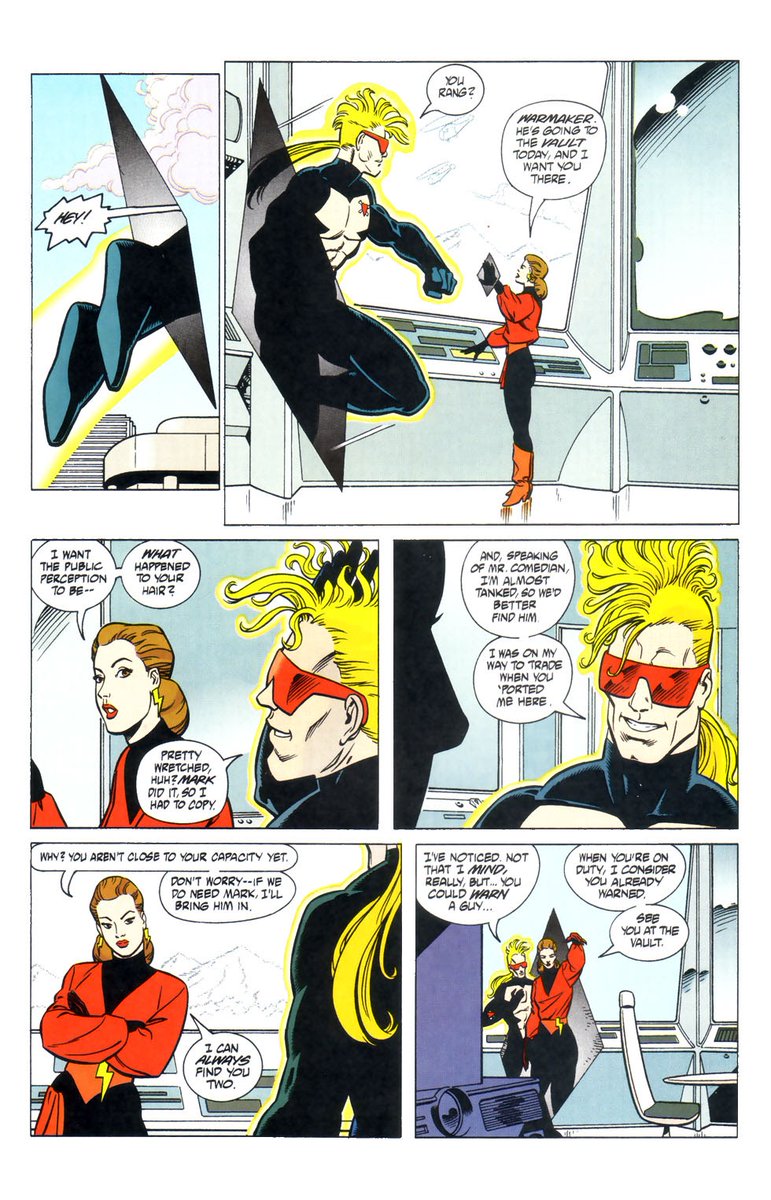
"Rebel" is in fact a superpowered persona shared by two brothers, the straight man Mark and the bad boy Matt. They swap the form around by high-fiving. This is so radical. 
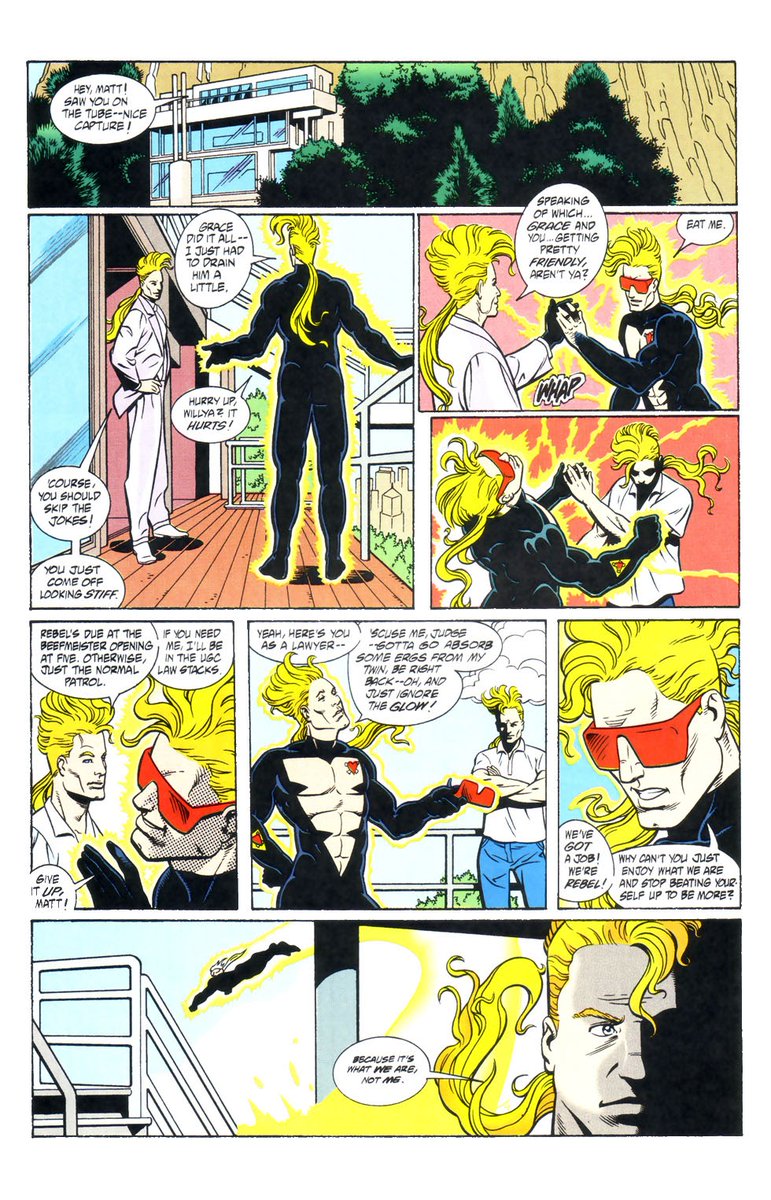
We are also introduced to Rhapsody, a beautiful woman with immense healing powers who distributes free aid to anyone who visits her and is one of the reasons Golden City is so beloved. 
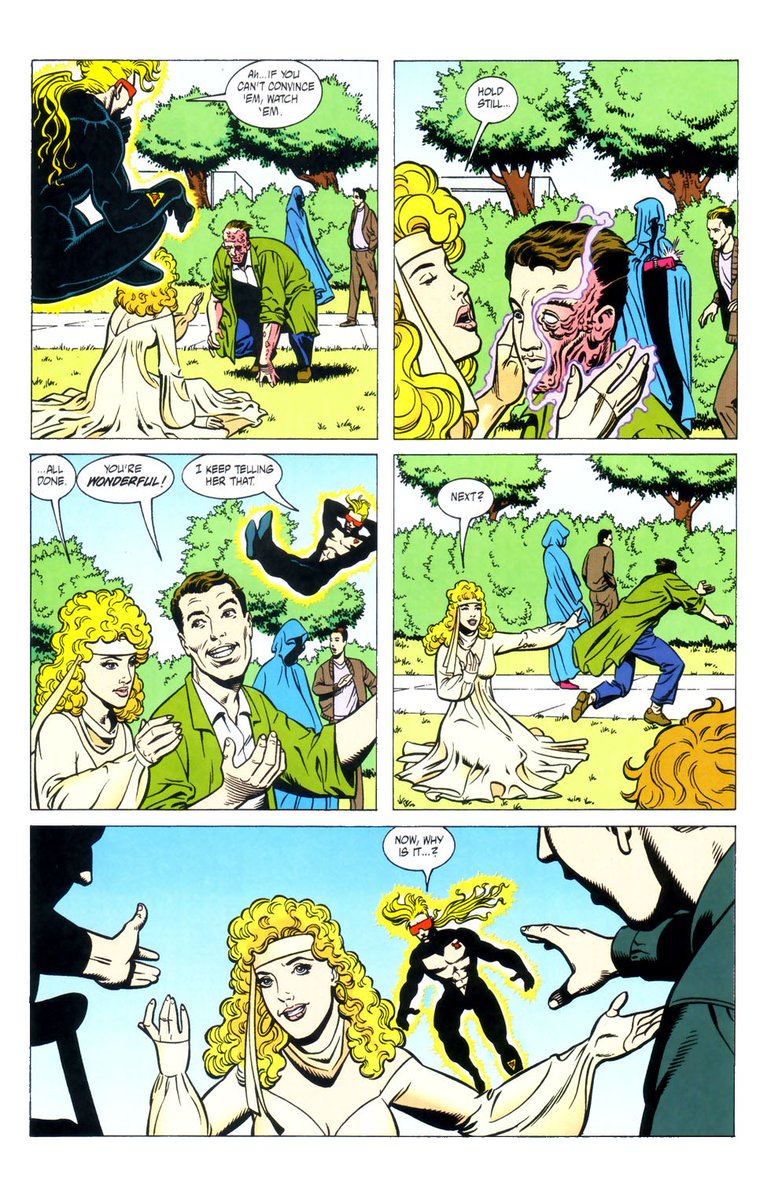
All the way through the series there's been a one-page preview strip running about an alien scientist who arrived on earth decades ago, hunted by an unknown enemy and who performed experiments which... well. Things did not go well. 
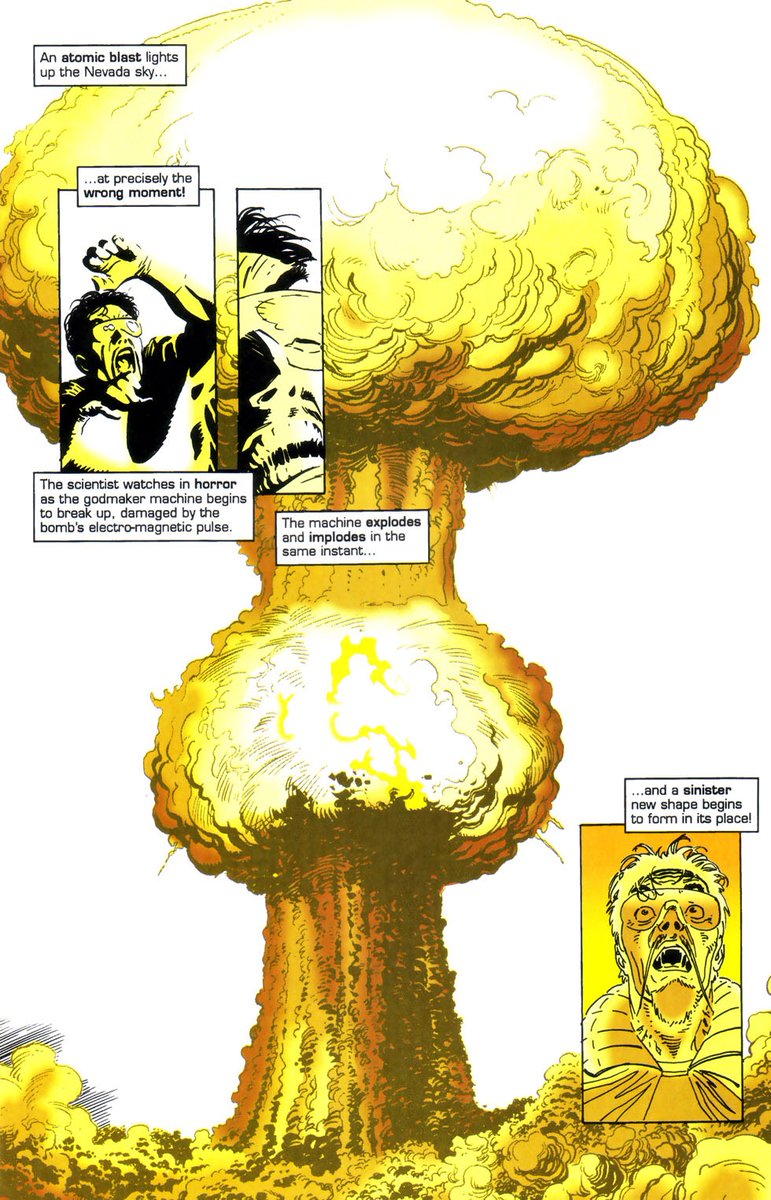
Next up is Mecha who is very different from the 1987 title of the same name. Mecha wears a warsuit made of alien technology and has wandered into Golden City on his own accord where he causes a ruckus while trying to fight crime. 
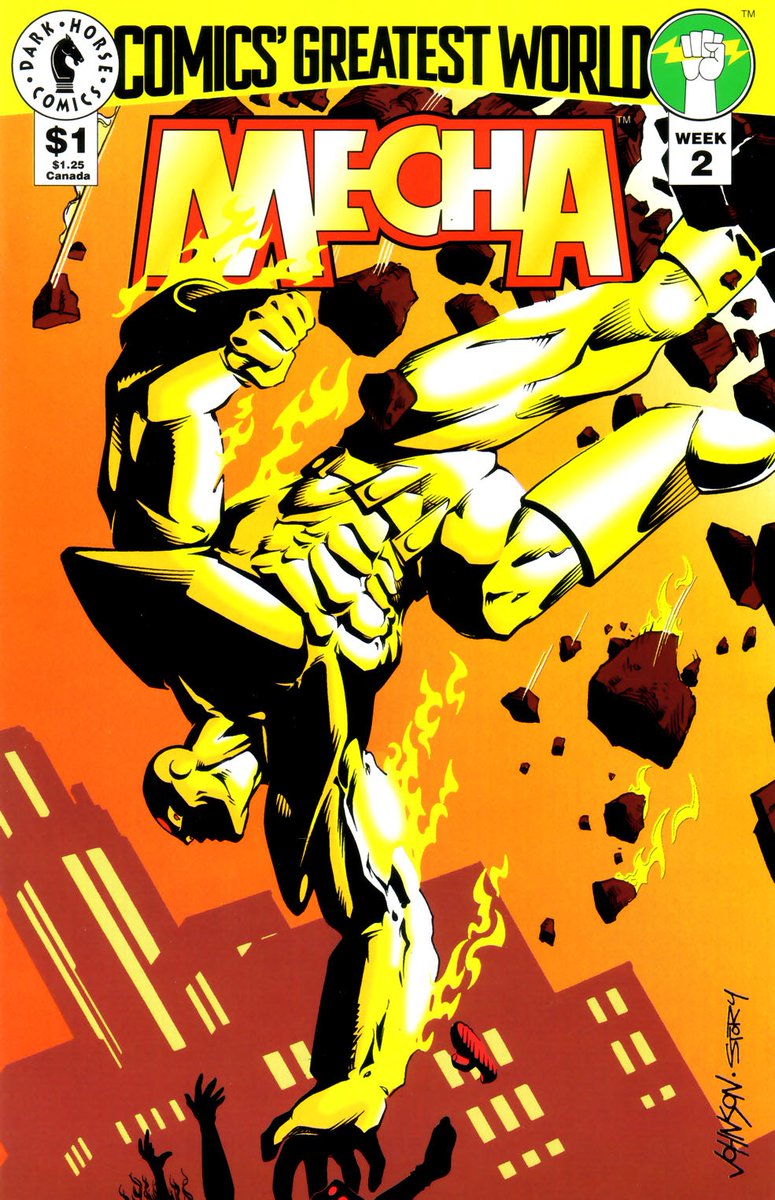
He ends up embroiled in a melee with the supervillain Warmaker who the aliens have released from Grace's prison. Art for this issue by Chuck Wojtkiewicz and John Lowe 

Week 3 for Golden City introduces Titan and well.. look at him. He's our resident Superman expy, with the powers to match. All the Golden City issues were written by Kesel and this one has art by Brian Apthorp and Jimmy Palmiotti! 
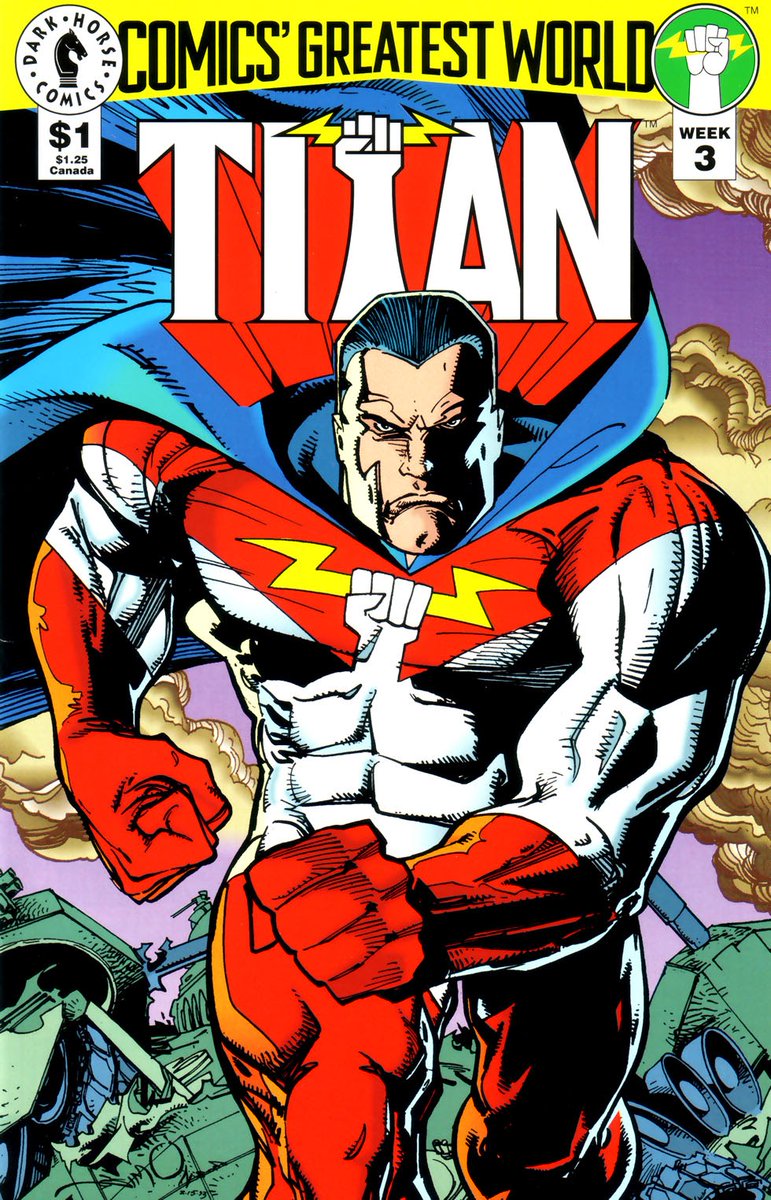
Titan initially appears to be very Superman-esque, intervening in the destructive fight to save people and subdue Warmaker... 

The fourth and final Golden City issue brings the city's protectors as a team to oppose Warmaker, including Ruby who is plagued by disintegrating powers and came there for a cute. Another Kesel story with a Perez cover and Jan Duursema and Damon Willis on interior art. 

Incensed by Warmaker's taunting, Titan recklessly attacks him and in the struggle Rhapsody is killed, not being immune to death herself. And right in front of her boyfriend Rebel as well. 

The tragedy galvanizes Grace to publically declare that Golden City is seceding from the United States, becoming a sovereign territory! 
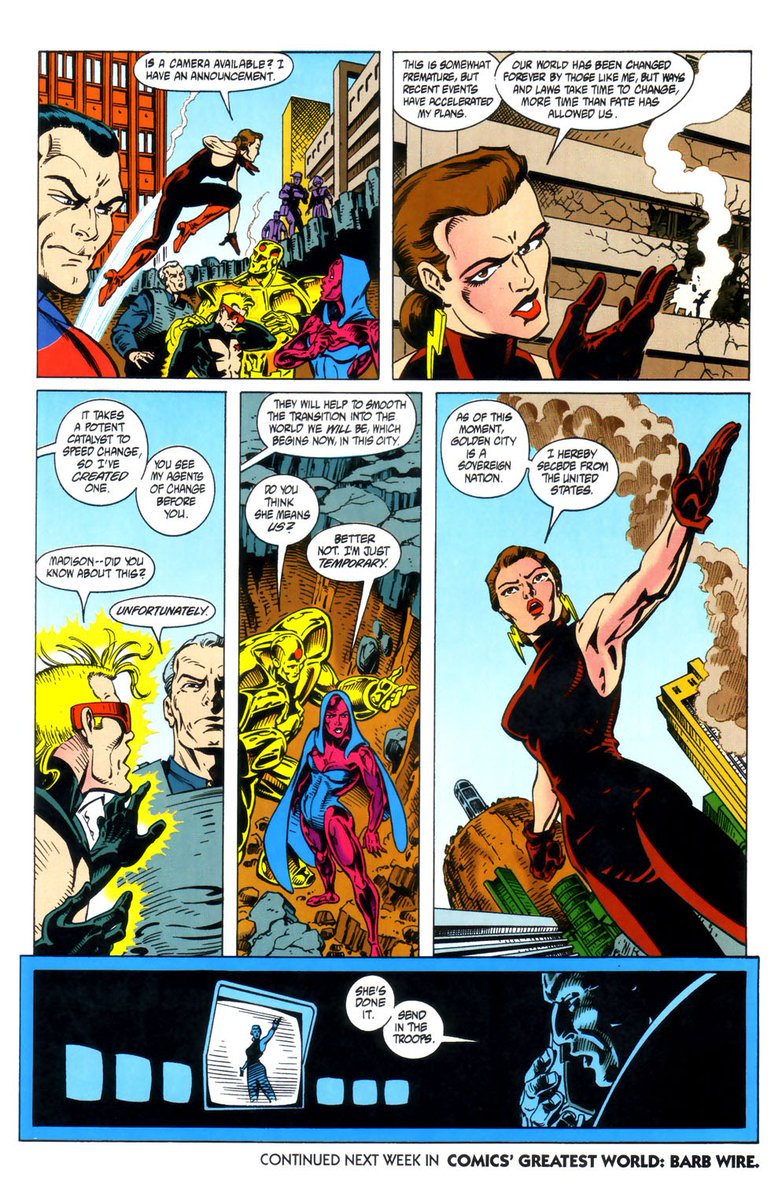
Now we come to the third CGW character that you may have heard of - Barb Wire! Yep, the 1996 Pamela Anderson movie was indeed based on a comic, though the movie obviously takes a lot of liberties with the setting and character. 
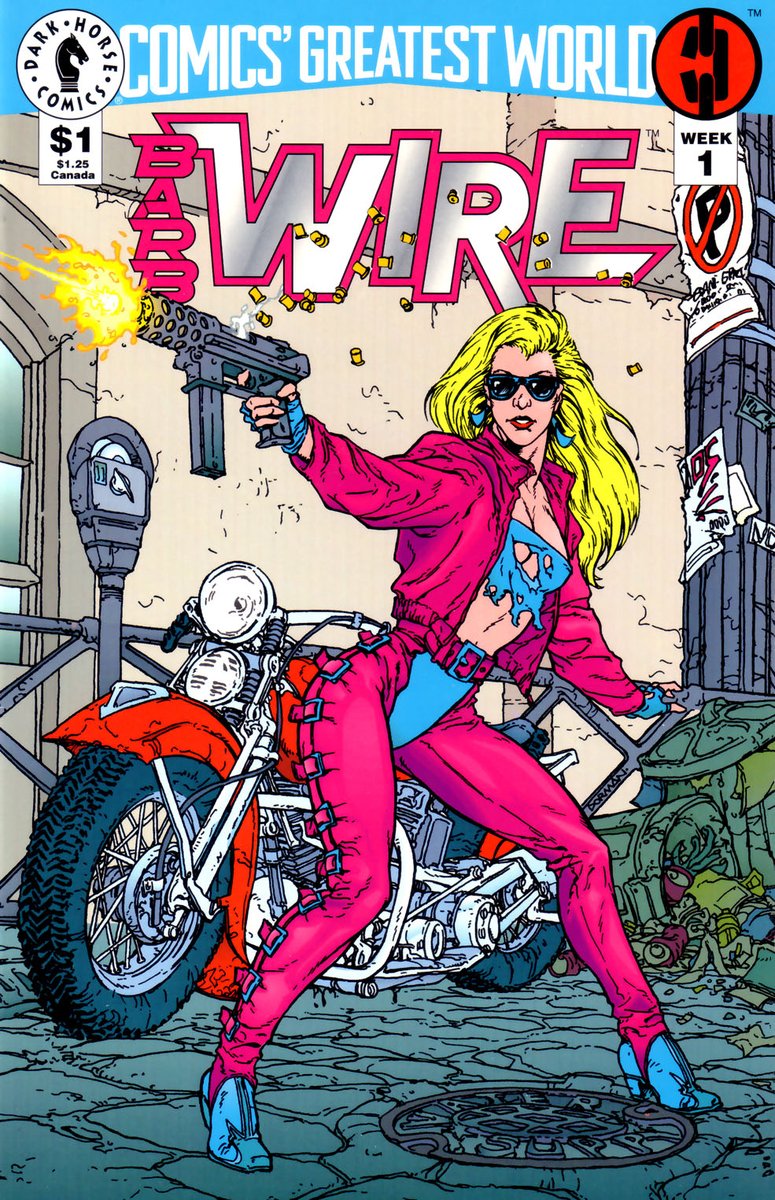
Steel Harbor is an urban dystopia, the remains of a once-successful industrial city. Think Detroit by way of Mad Max. All the Steel Harbor titles were written by Chris Warner and Barb Wire has art by Paul Gulacy and Dan Davis. 
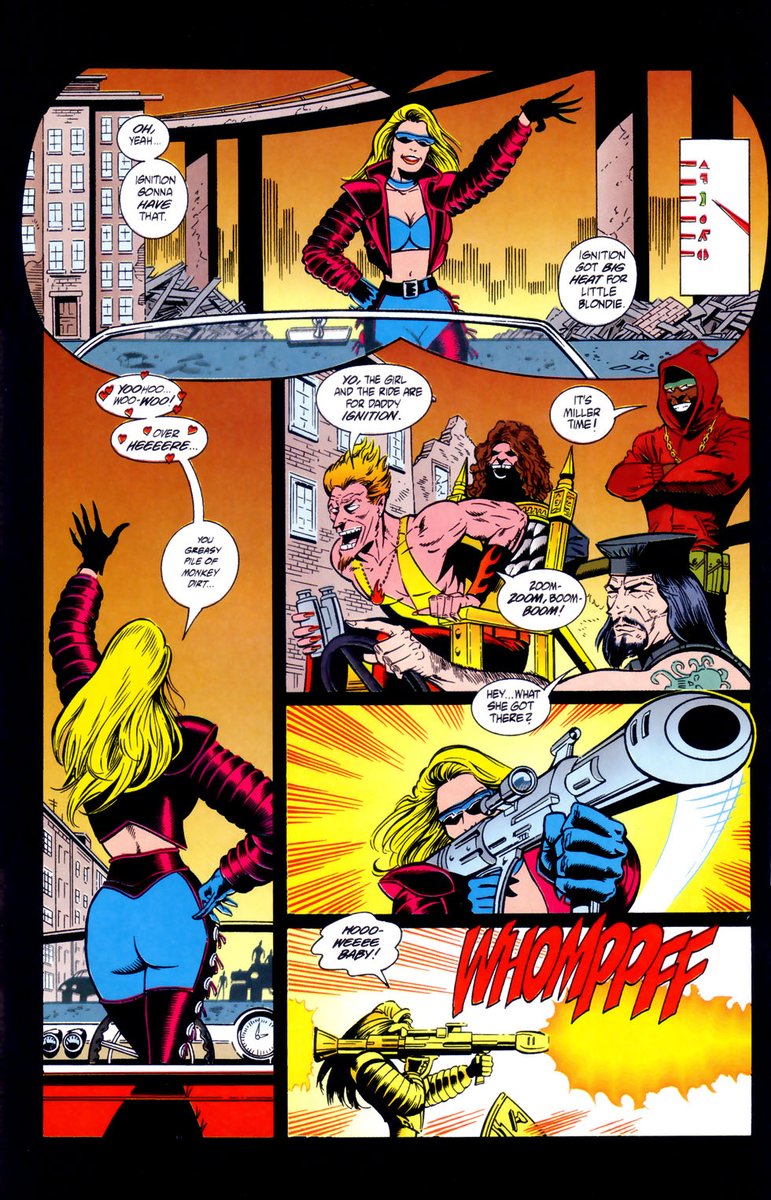
Anyway Barbara "Barb Wire" Kopetski is a smart-mouth bounty hunter with a love for heavy weapons, bikes and a snappy comeback for everything! She apprehends a superpowered gangleader named Ignition. 

Next up is our first Mike Mignola contribution - even if it is only a cover! The Machine is Avram Roman Jr. an experiment into cybernetics who escaped to live a reclusive life in Steel Harbor while wrestling with his half-human nature. 

Spectacular art from Ted Naifeh and Clem Robbins in this issue as the Machine is brought into the riots surging through Steel Harbor. 
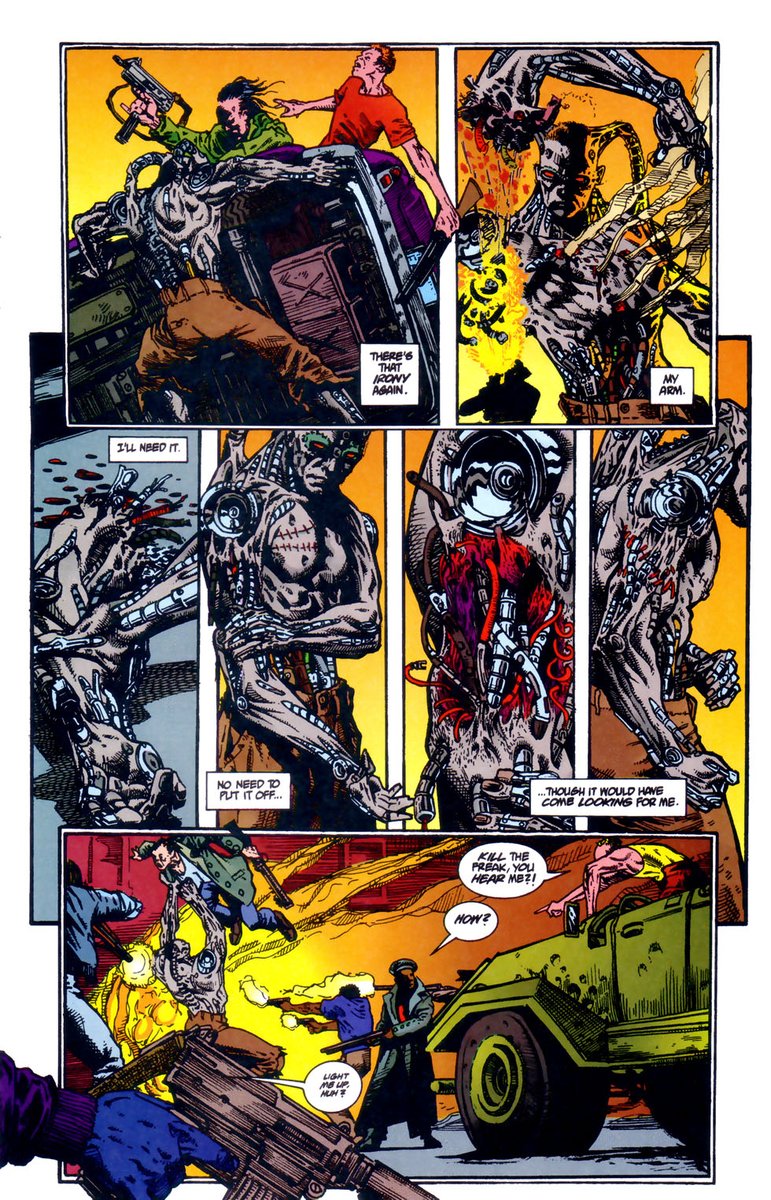
The issue introduces Mace Blitzkrieg and his Prime Movers, one of the biggest obstacles to peace in Steel Harbor. Mace is quite a violent, overbearing chauvinist asshole and is the foe in many a forthcoming issue. 
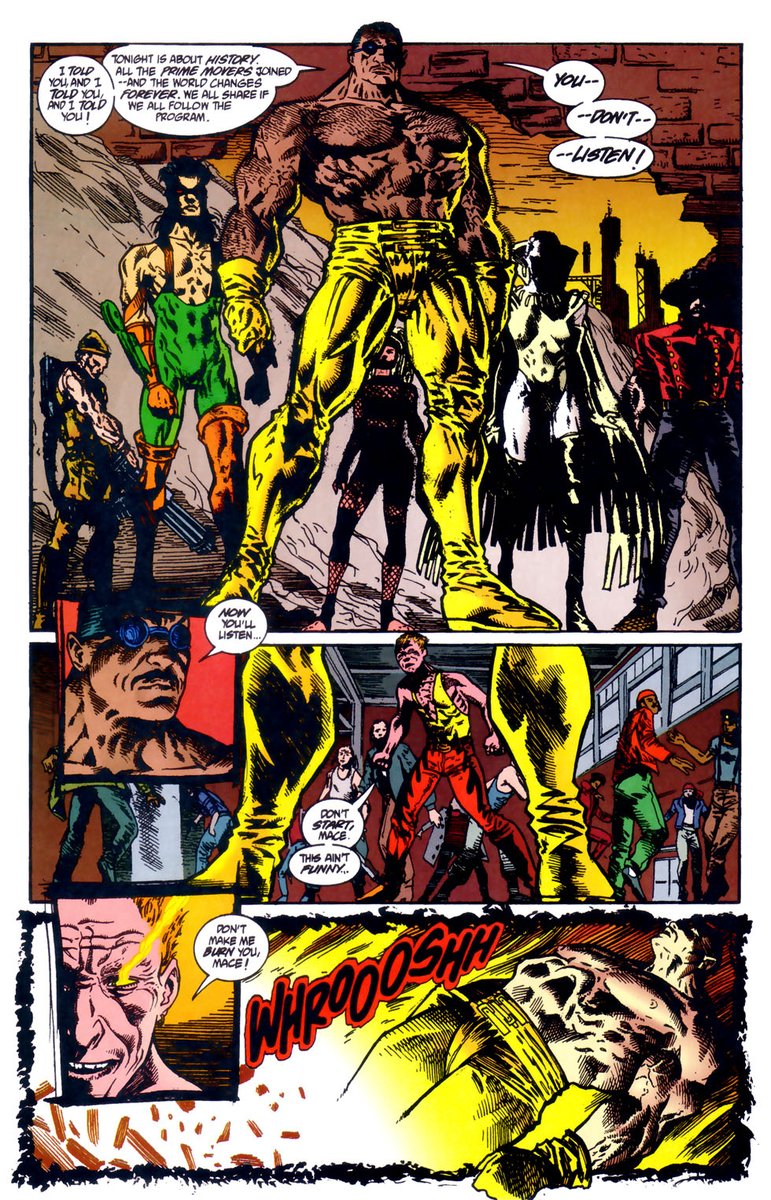
Issue 3 sees Warner do art as well as writing and introduces super-powered street gang the Wolf Gang. Another rather group that do nothing for me, no doubt inspired by the many news panics on gang violence of that era. 
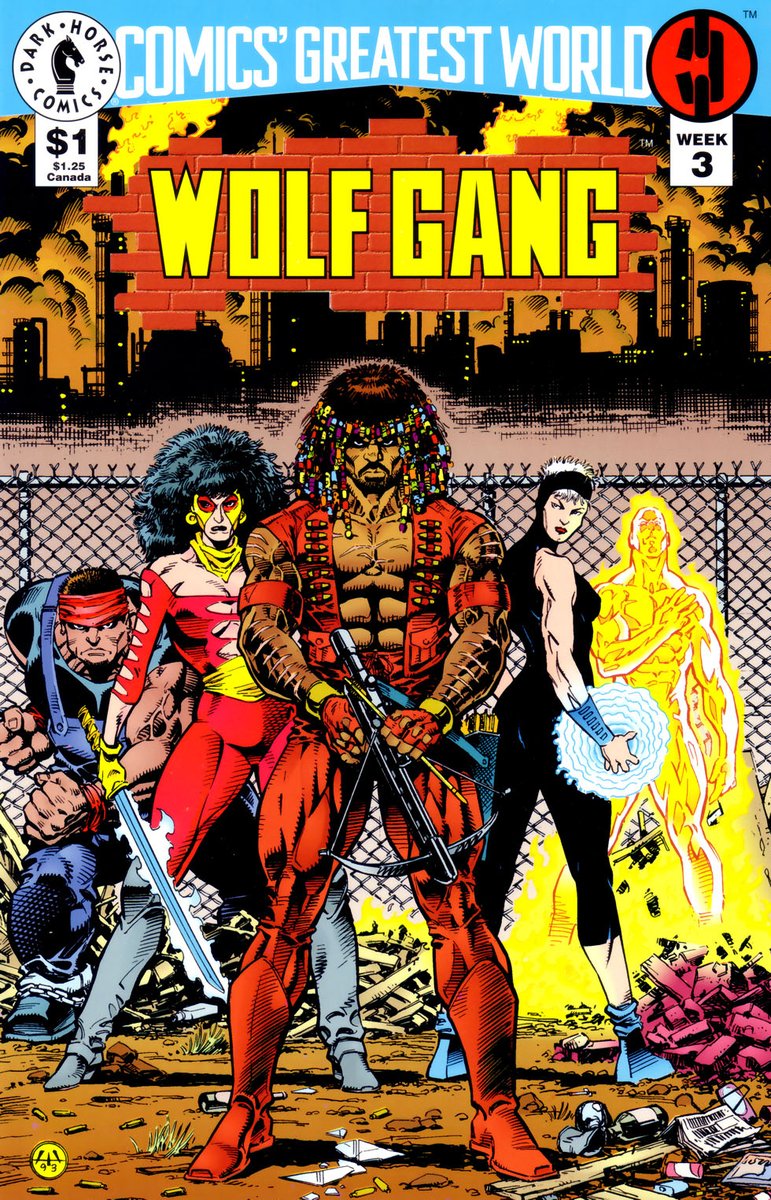
The final Steel Harbor issue introduces Motorhead, aka Frank Fletcher, a man with the misfortune of being the current host of a talkative presence called the Motor which endows him with vast superpowers. 

Motorhead turns out to be what was needed to turn the tide and he summarily defeats Mace, giving the others a chance to mop up the gang. And that's it for Steel Harbor! 
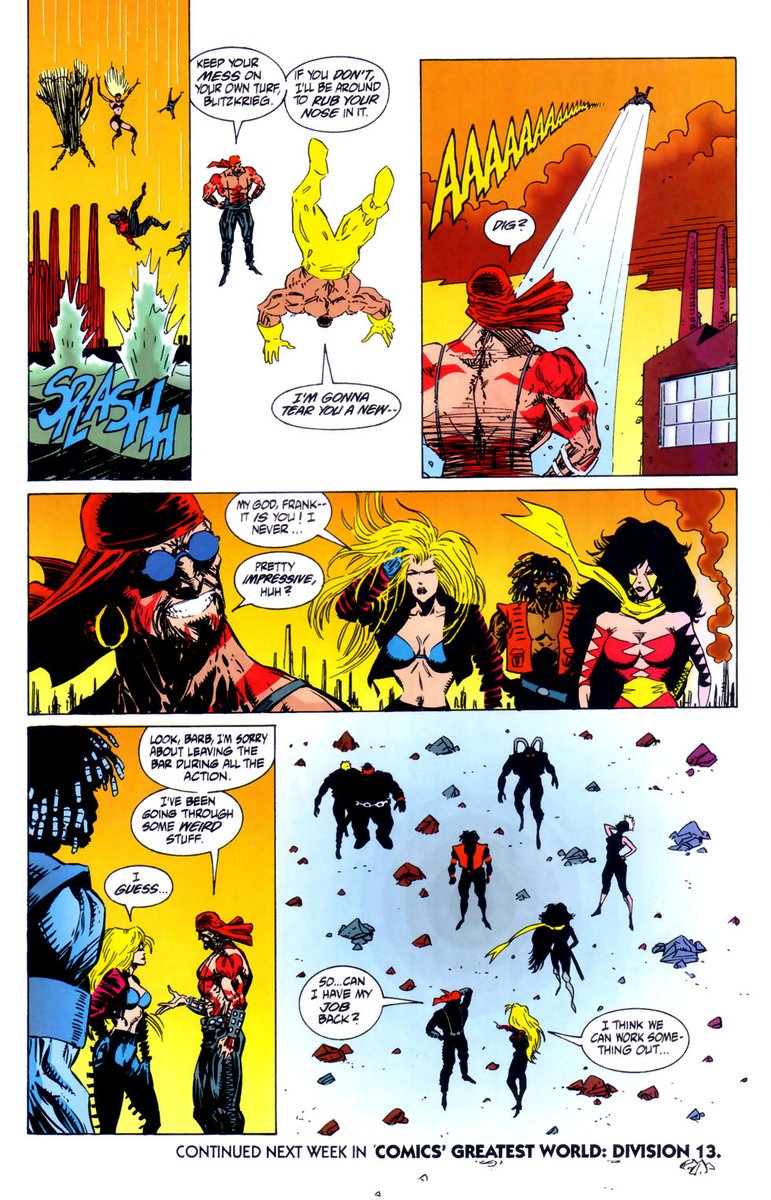
The final mini-series is devoted to Cinnabar Flats, the site of the mysterious Vortex. The Vortex is both a portal and an energy source and the US Government has imprisoned and studied anyone affected by it in the to-secret Block 13. 
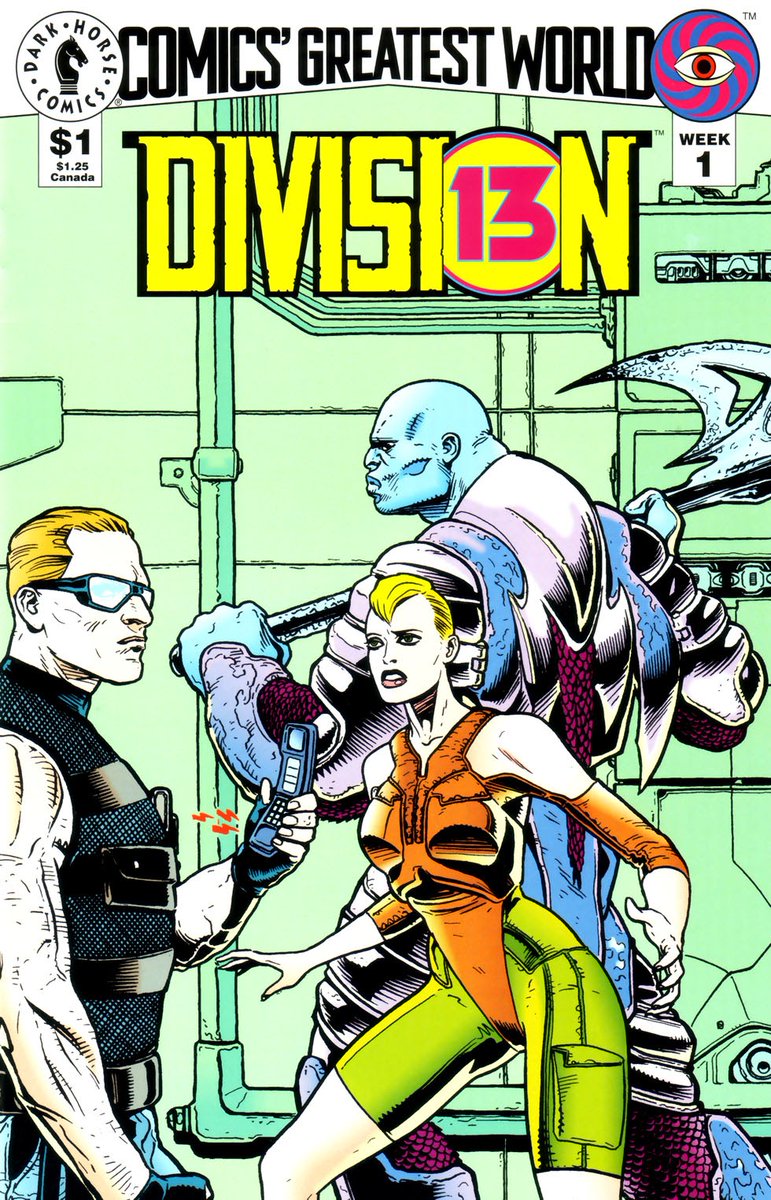
The Vortex issues are written by Stradley with art by Doug Mahnke and Randy Elliot for this issue! The mysterious aliens have concluded that the many superhumans and other anomalies originate in the Vortex and have arrived to investigate! 

This battle allows the escape of three mutated inmates from Block 13 now known as Flux, Lamb and Wrath who form the runaway Division 13. 
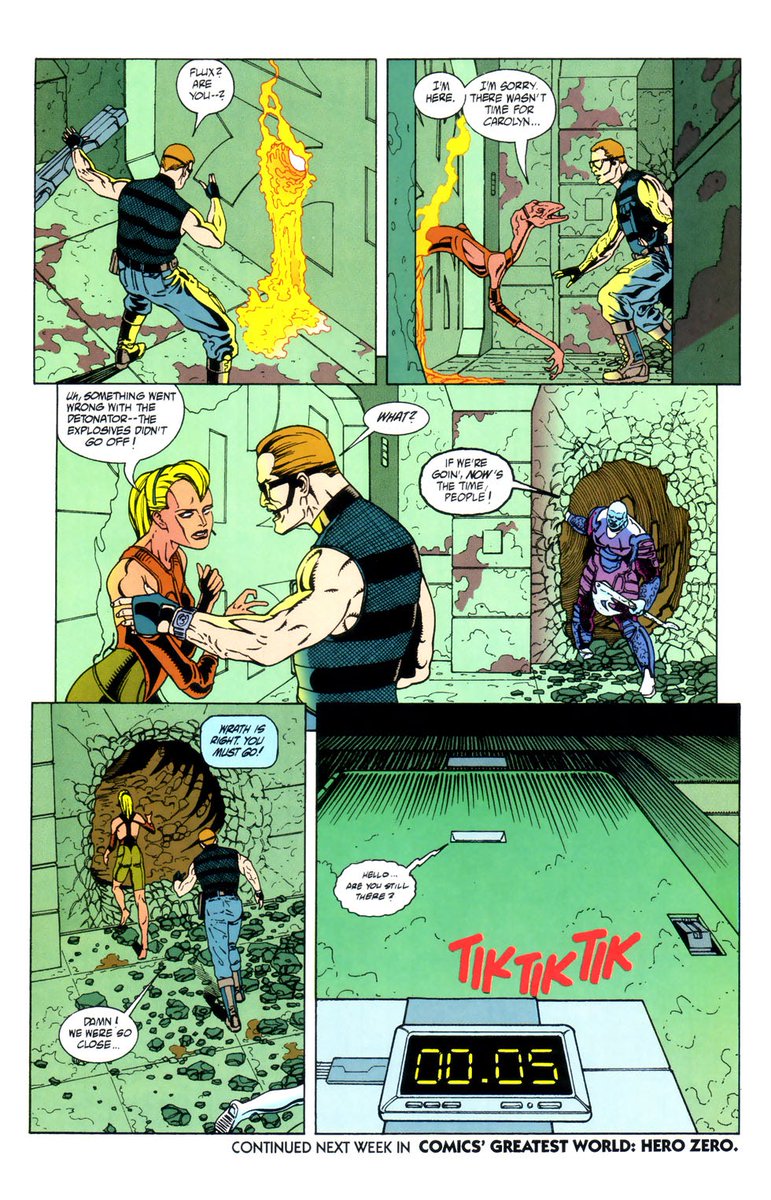
The next installment is Hero Zero, a concept probably inspired either by Ultraman or Jet Jaguar or both! David McRae is a young man bonded to an alien artifact that allows him to transform into the size-changing mecha Hero Zero! 

In true toku fashion he gets to duke it out with a giant dragon released by the aliens meddling with the Vortex with really great Eric Shanower art to boot! 

Week 3 of the Vortex gives us King Tiger, a young monk devoted to slaying and exorcising demons! This chapter has excellent Paul Chadwick and Jimmy Palmiotti art 

The whole introduction series ends in Into the Vortex by Stradley and Bob McLeod behind a Frank Miller cover! While the various heroes deal with the menaces unleashed by the alien "Seekers", the army including Eileen Anderson investigate the invaders... 
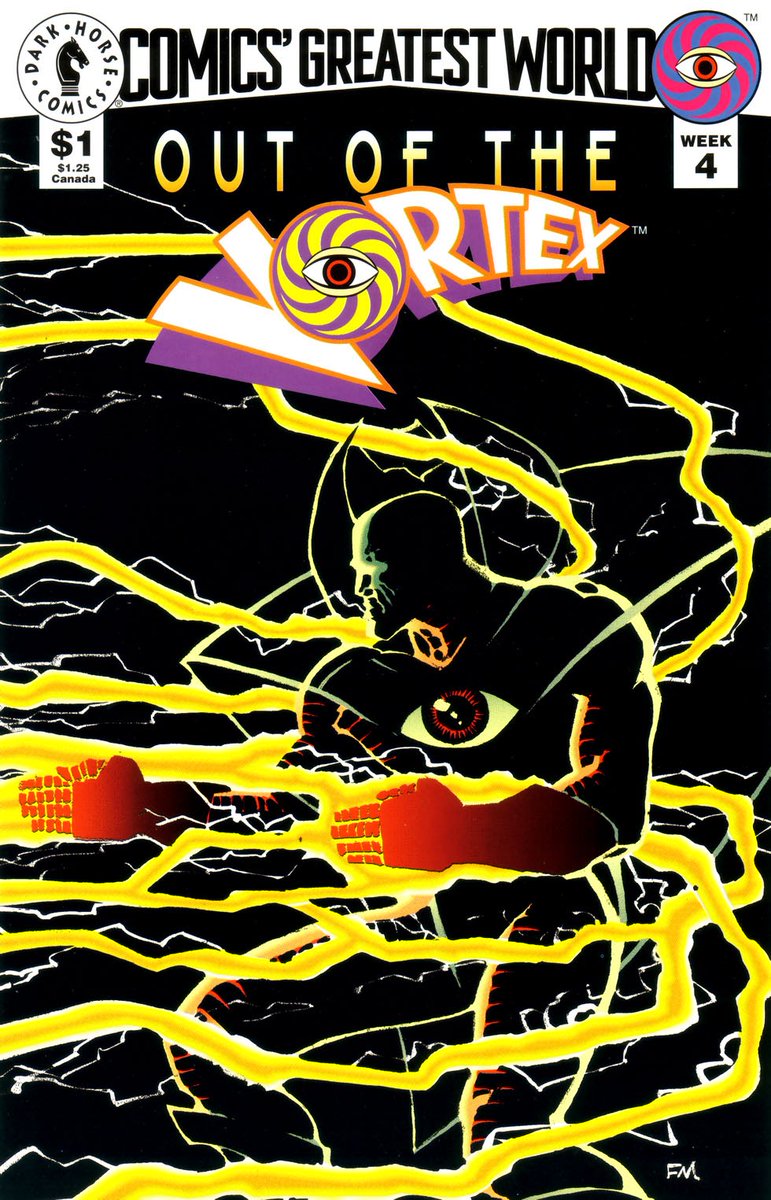
Their meddling with the Vortex has unforeseen and unwanted consequences when they release another mysterious alien from the depths of the swirling maelstrom... and the whole series ends with a cliffhanger! 
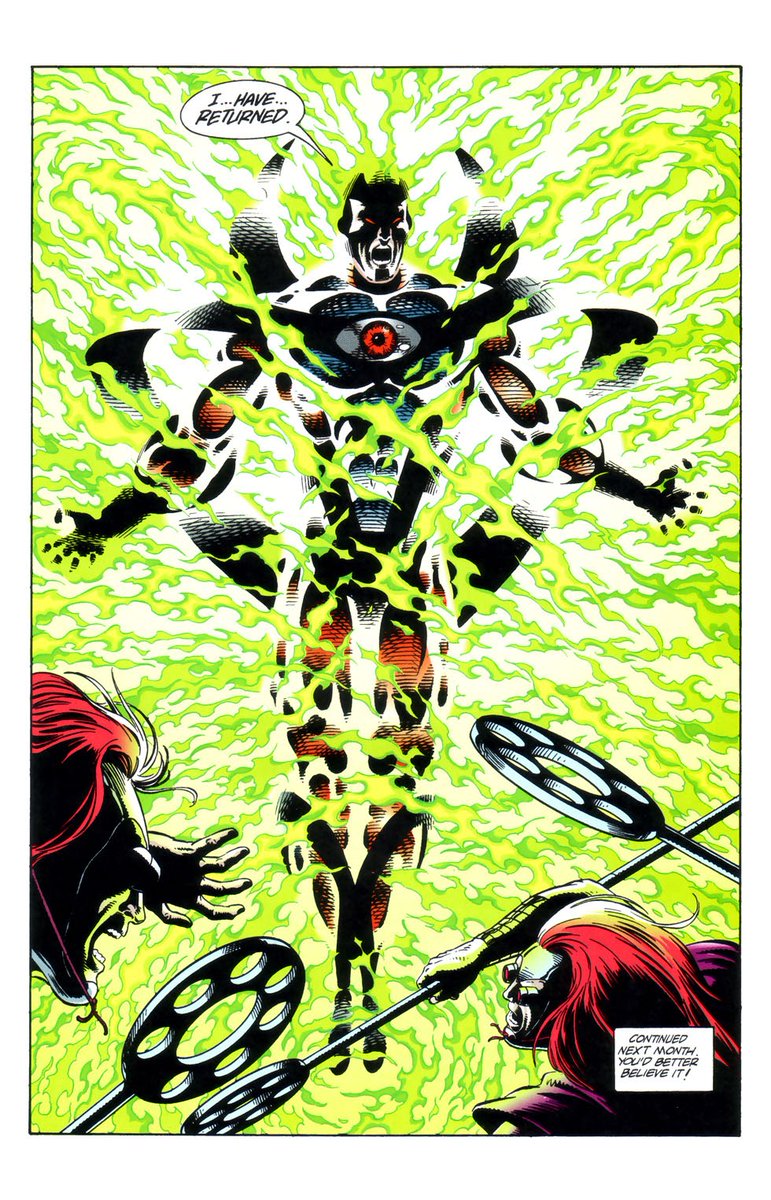
With the special weekly series over, Dark Horse started the first ongoing series called simply "Out of the Vortex" right after, which picked up where the story left off. 

The first issues sees the newly arrived alien deal swiftly with the Seekers and despite heavy losses from the military the aliens are destroyed. 

From here on out, rather than summarize every issue and series I am going to instead go through the publishing history of the imprint, now that the stage is set.
Out of the Vortex revealed that the mysterious newcomer is actually the alien scientist seen in the flashbacks...
Out of the Vortex revealed that the mysterious newcomer is actually the alien scientist seen in the flashbacks...

...who had accidentally created the Vortex which created superhumans and distributed monsters and alien technology all over earth. The series sees him befriend Eileen Anderson and engage the masters of the seekers to defend earth. 

in 1994 Dark Horse began releasing more regular and limited series to expand the narrative, including several issues dedicated to CGW poster boy X. 

X's first series ran for a whopping 25 issues, being the second most long-lived of the CGW titles. Originally by Steven Grant, Doug Mahnke and Jimmy Palmiotti this title is high recommended if you want a hard-edged but not over the top vigilante story with plenty of mystery. 

I shall not spoiler what happens in it or who X actually is, but instead suggest you check it out. It's a good read and an underrated gem from the era. 

1994 also saw the Machine get his own title in which he continued to struggle with his humanity but the series succumbed after only four issues due to poor sales. Note that each CGW title was initially coded with its respective cities icon on the cover. 

A Motorhead Special also came out which gathered the Steel Harbor heroes once again against the menace of Mace Blitzkrieg and his Prime Movers. 

Another issue to come out was the first Ghost Special by writer Eric Luke and artists Matt Haley and Tom Simmons in which we learn that Ghost is searching for her own killer, which is why she's constantly shaking down the criminals of Arcadia! She also clashes with X again. 

I'm only posting this page because it is a RECURRING thing that Ghost just totally dunks on the badass heroes and villains she encounters. This happens almost every time she meets X. 
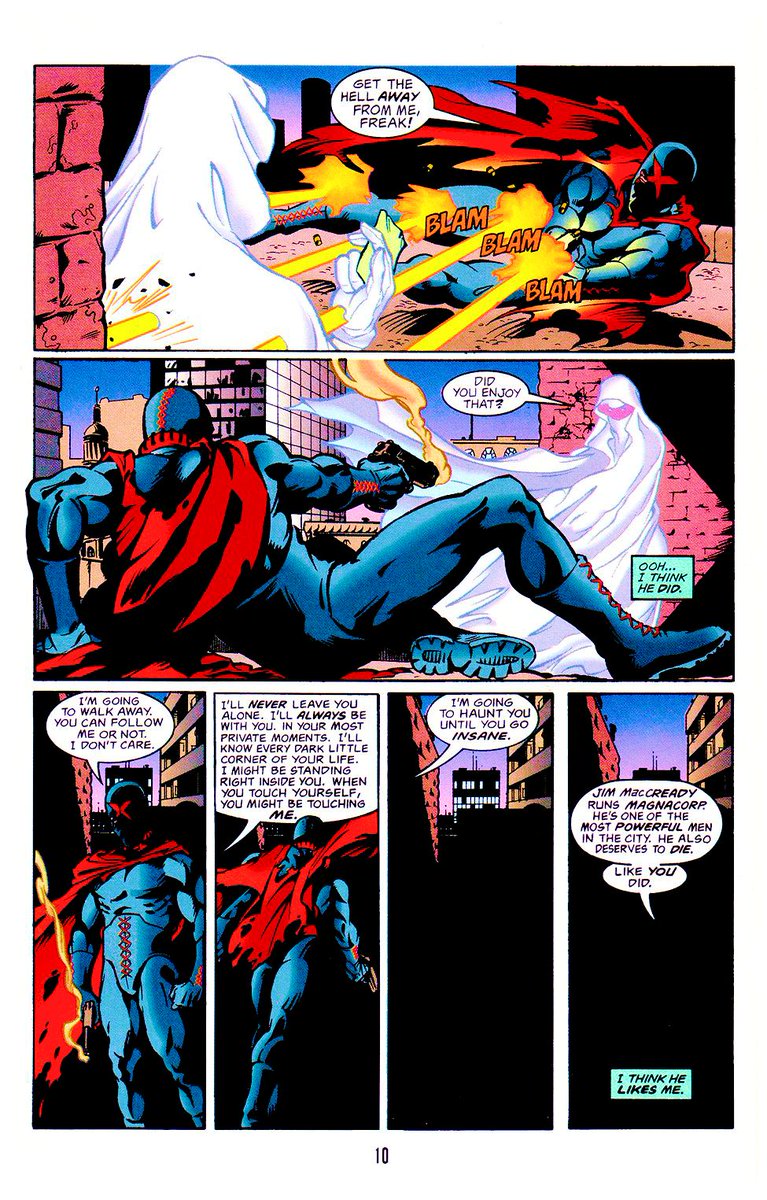
Catalyst: Agents of Change was the sole Golden City title to come out in 1994 and chronicles Grace's team struggling with the US Government not taking her secession lightly as well as Titan growing ever more erratic. 

Suffering from an absolutely out of control inferiority complex coupled with the powers of Superman, Titan eventually rebels against Grace and she is forced to teleport him away from the city, but that is only the beginning... 
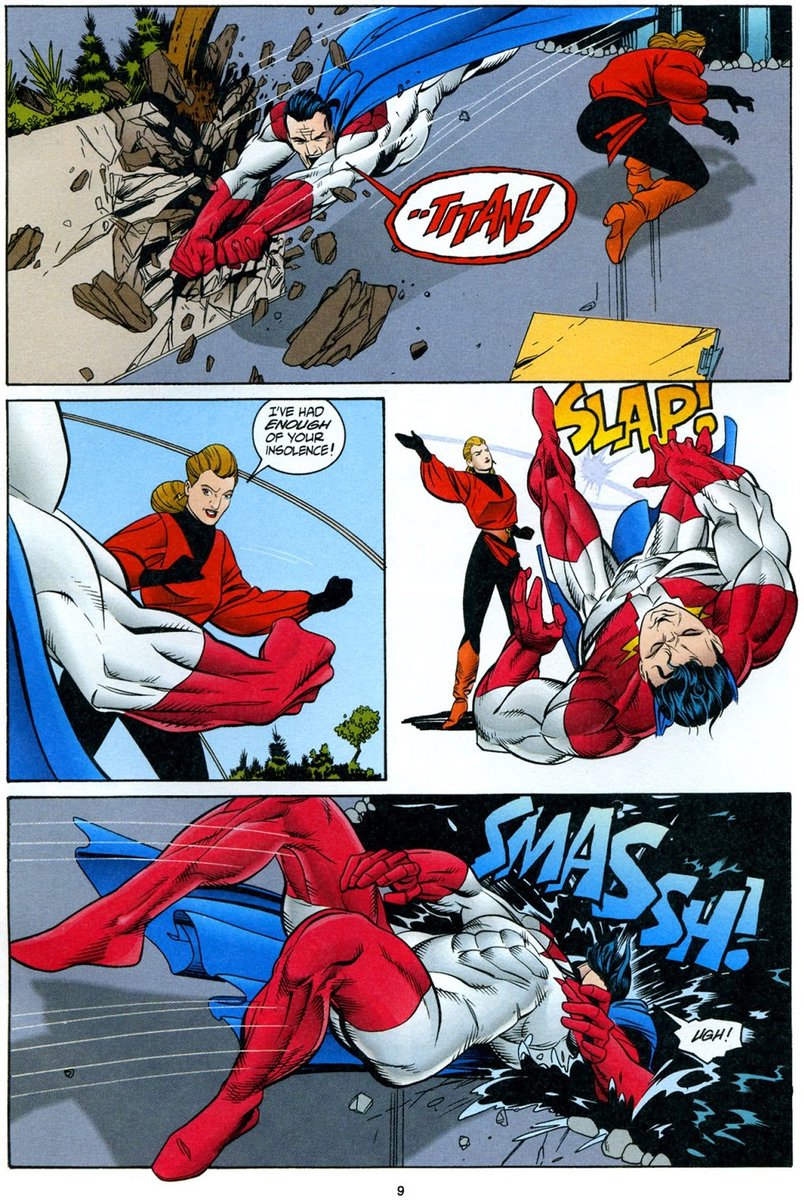
Division 13 was the final title to be launched in 1994 and it was written by legendary scribe Keith Giffen with art initially by Alexander Morrissey and Keith Aiken. Also canceled after only 4 issues, this series explored the team's origins and the horrors of Block 13. 
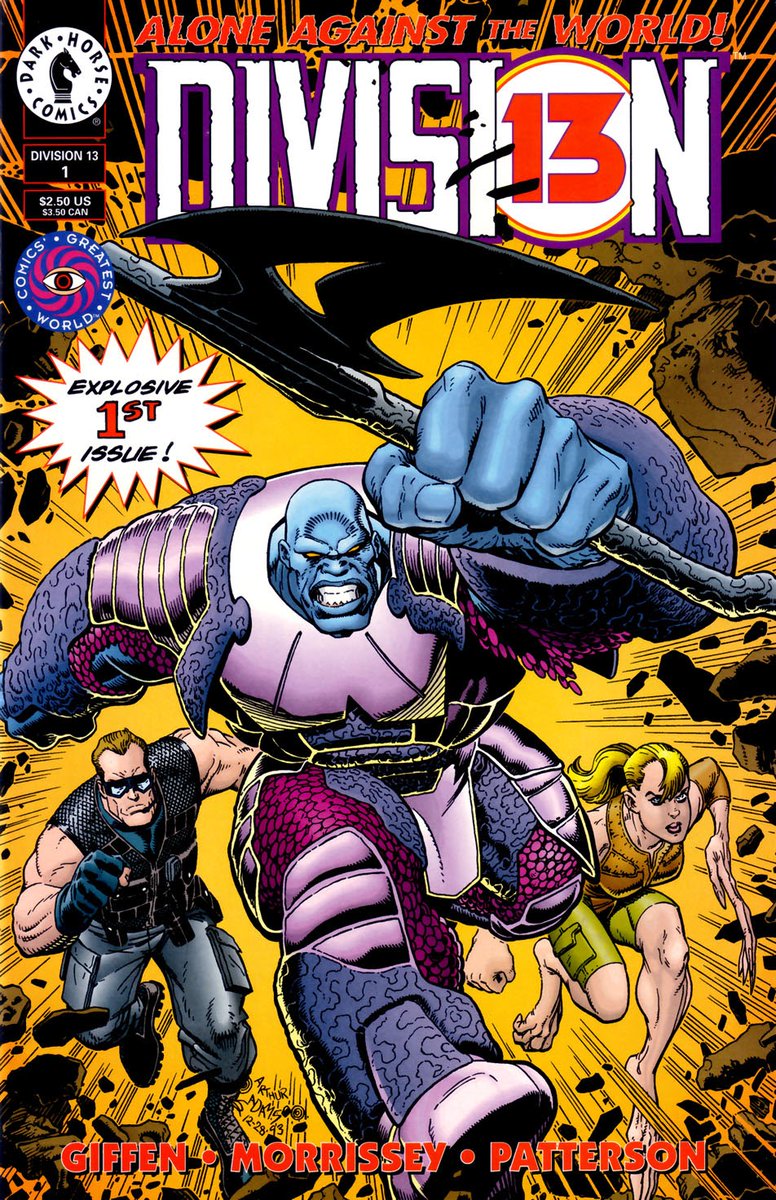
The series also introduced another Vortex-mutated human in the form of the extremely powerful and charismatic Law. He'll turn up again... 

1994 also had a second CGW event in the form of Will to Power, a 12-issue weekly series with a $1 cover price much like the introduction crossover. 
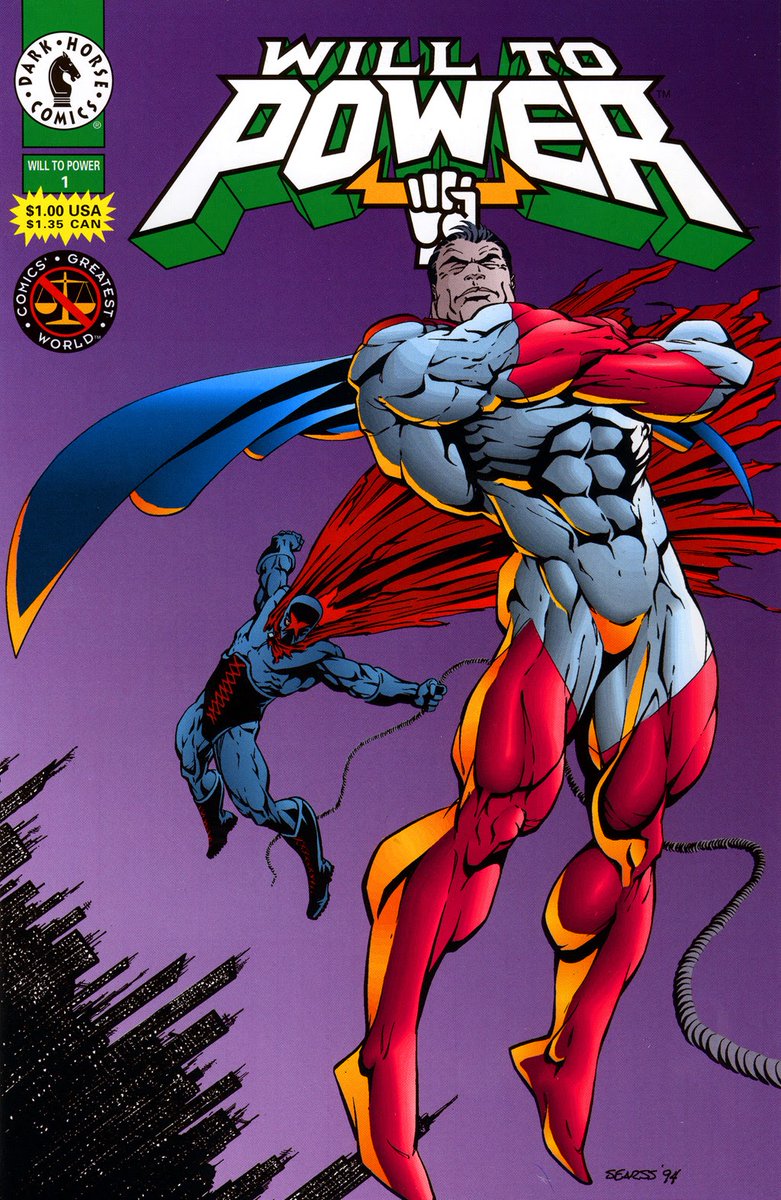
In this series the now insane Titan decides that he's had enough of all the "lesser" superhumans of the world and goes on a rampage, clashing with costumed crimefighters, monsters and aliens alike in his quest to bring order to the world. 
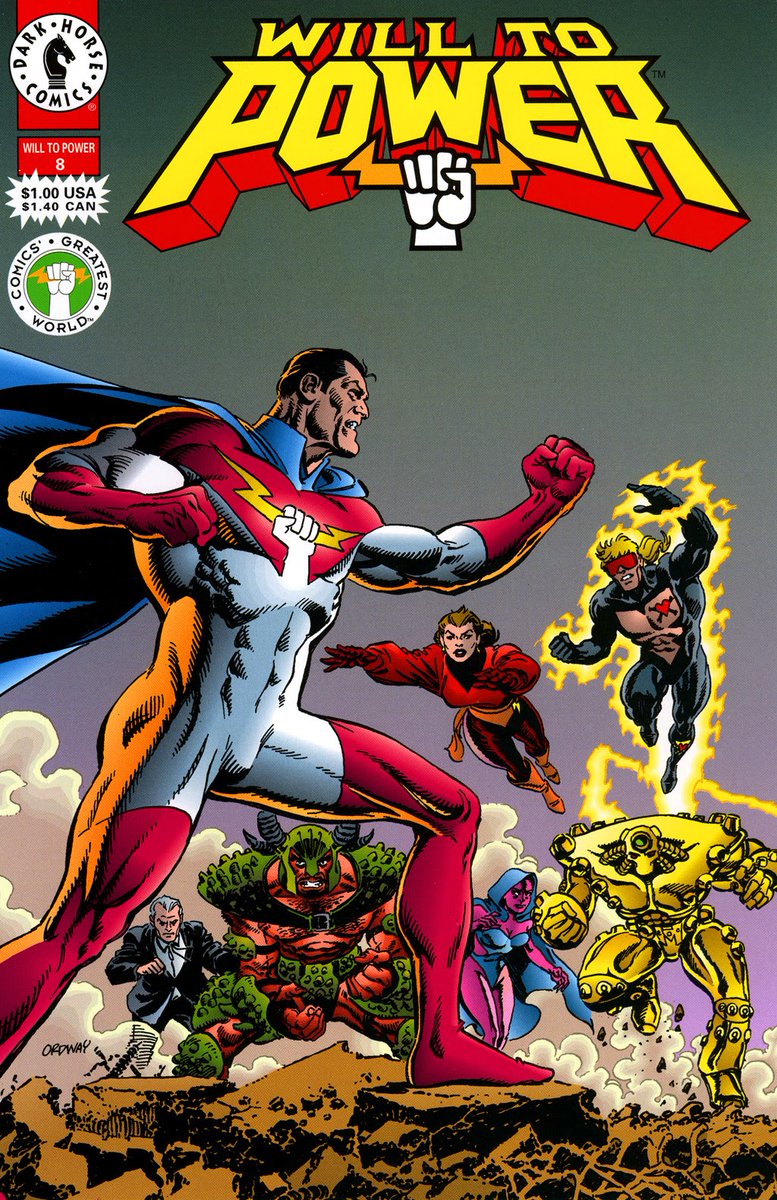
Titan's rampage ends up finally claiming one life too many. Lieutenant Anderson is killed by the madman... 
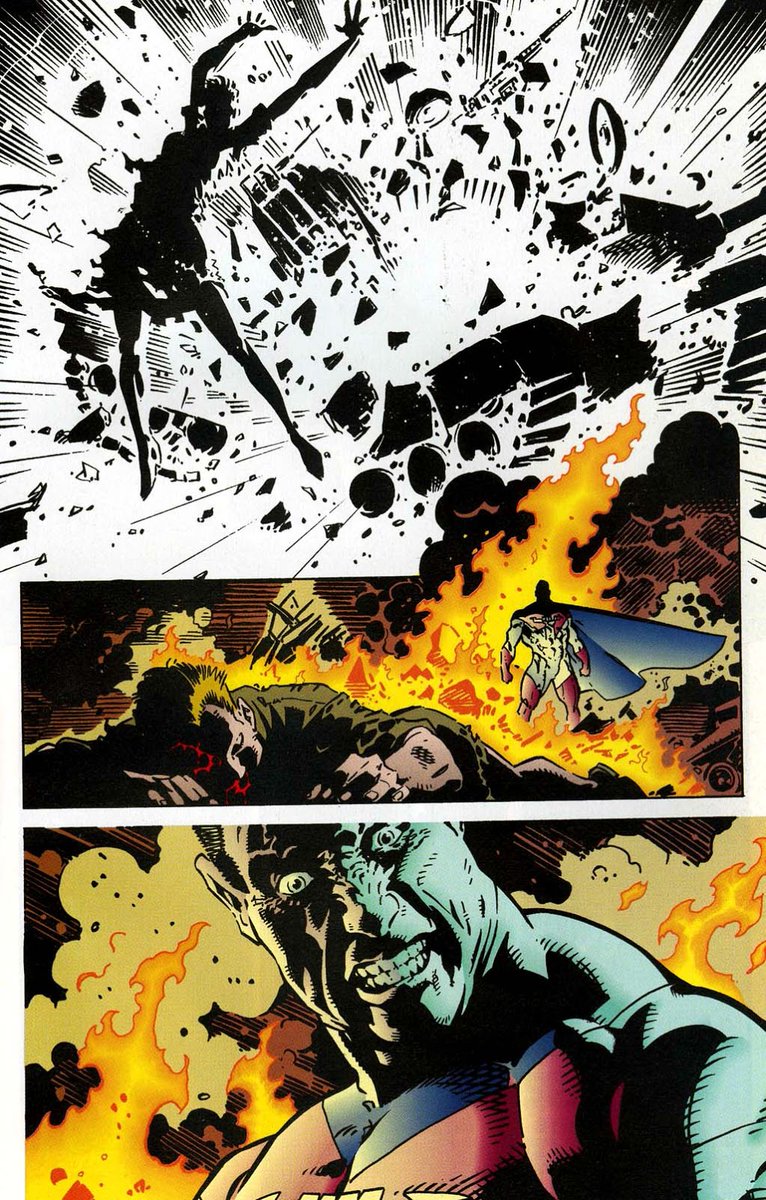
As you can see the Comic's Greatest World project never launched that many titles, mostly due to the unfortunate state of the comics industry at the time. Even by 1994 many publishers were closing, and Dark Horse editorial were open about these reasons in the editorials.
In 1995 The Mask crossed over into the CGW universe! Or were his comics always set there? It's a bit unclear given the nature of the Mask, but in series such as "Mask World Tour" he visited the different CGW cities and annoyed their inhabitants endlessly! 

Despite the in-progress industry crash, 1995 saw the launch of the by far most successful title in the whole setting because this was the year Ghost finally got her own series! 
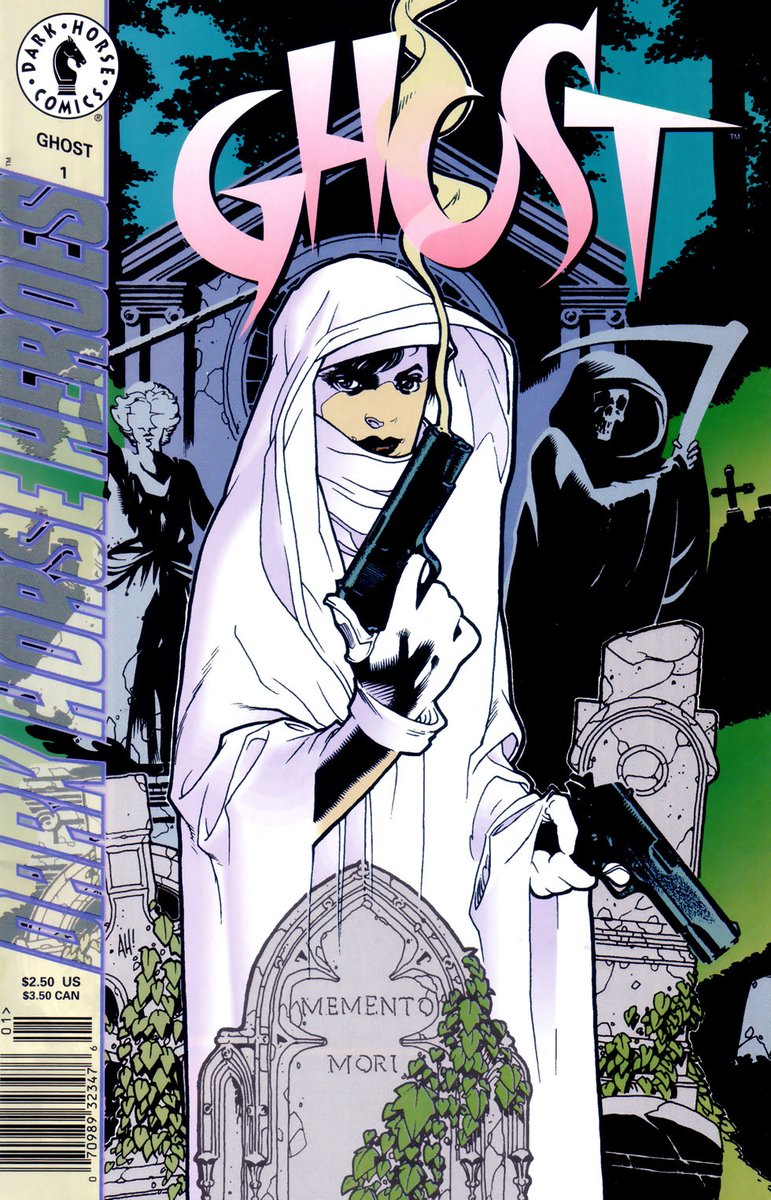
Still written by Eric Luke and with art by greats such as Adam Hughes and Scott Benefiel, Ghost ran for an impressive 36 issues during while the character went through a rollercoaster of wild events. 

Seeking her murderer on the streets of Arcadia, Ghost clashed with gansters, corrupt politicians, supervillains and superheroes in her quest for vengeance. 

The series was frequently concerned with Ghost fighting against exploitation of women such as going after abusers and casting couch producers. She also tried to keep her still-living sister Margo out of trouble with... not great success. 
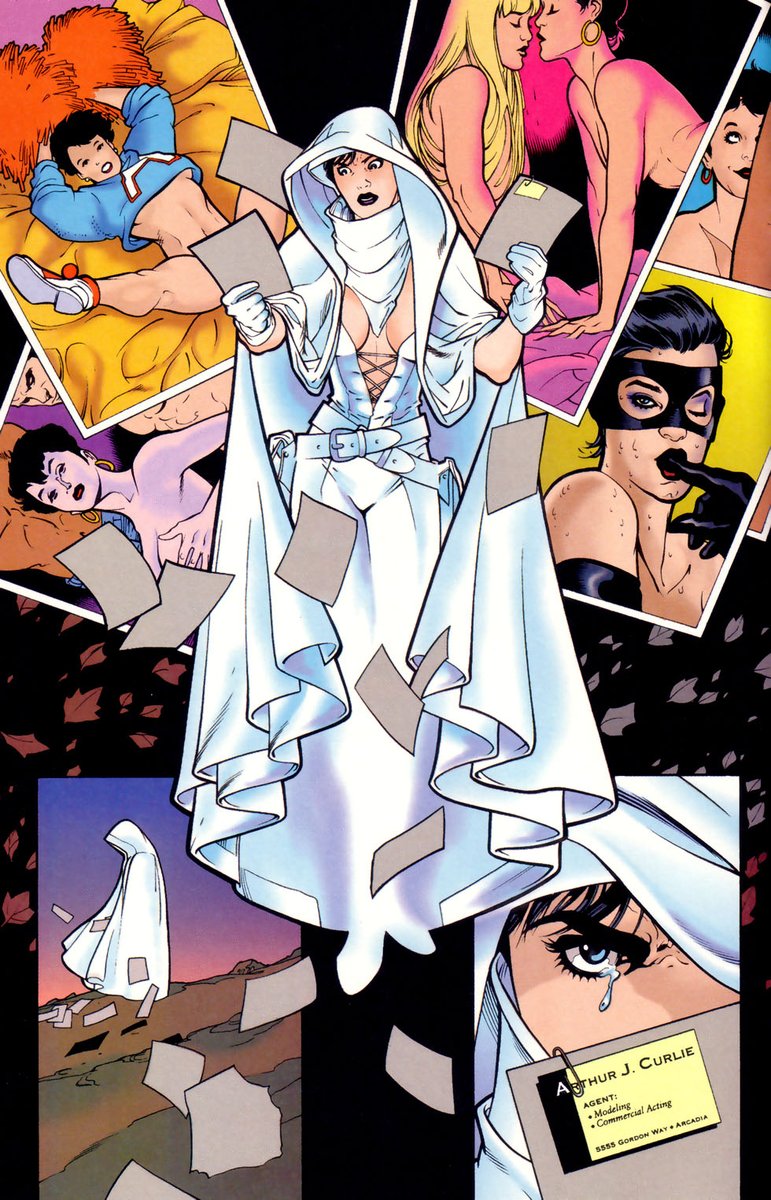
Like with X, I will suggest you check Ghost vol 1 out. I think it's an interesting and fun read and the central mystery is compelling. Elisa is a grim justice seeker, but that doesn't mean she and the comic can't have fun at times. 

Ghost also takes part in the monthly event where Predators (yes as in the movies) hunt the various Dark Horse characters and it is a fantastic 10/10 issue that I'm not going to spoiler for you. Go read it, if nothing else. 

Not far after Ghost launched, Comic's Greatest World was no more. And by that I mean the branding and the city-specific cover icons. Instead all the superhero titles were bundled under the generic "Dark Horse Heroes" imprint which included the 95 Mecha Special. 
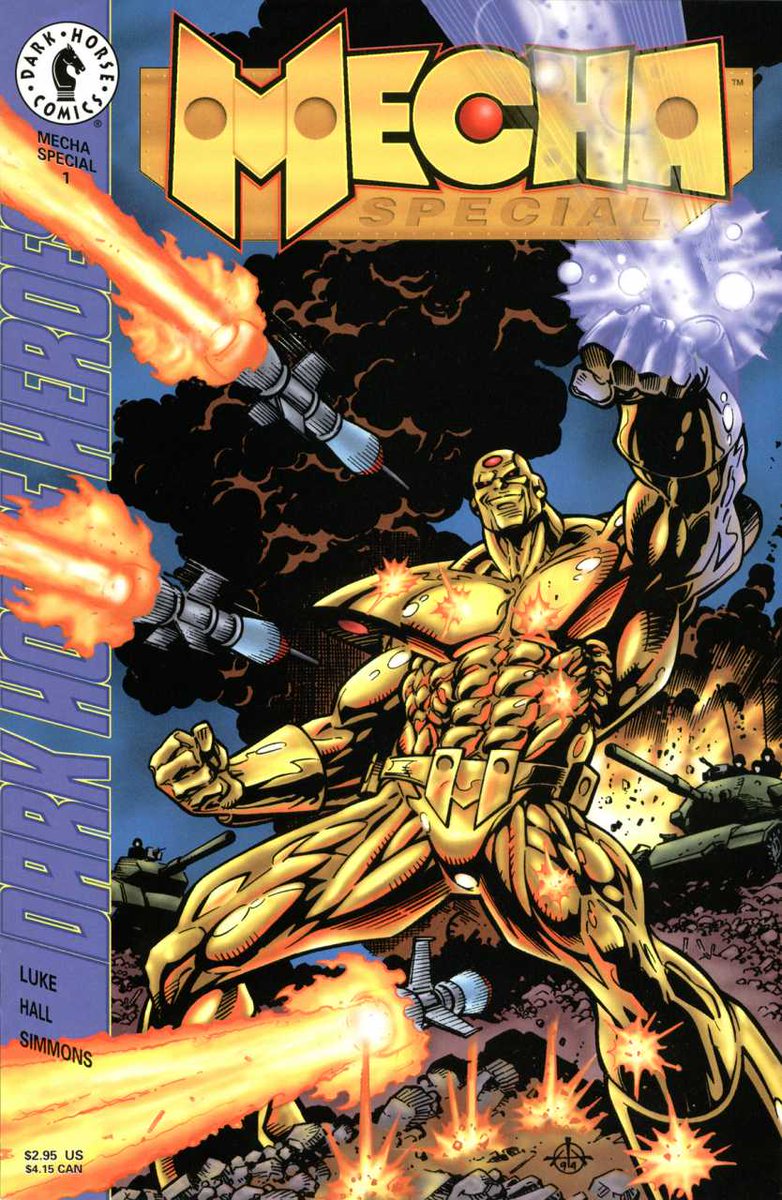
The only other new ongoing of 95 was Agents of Law, a relaunched and totally reworked Catalyst: Agents of Change. Keith Giffen and Lovern Kindizerski take over as writers with Dan Lawlis and Ian Akin on art and uhoh what's this... 

...and before she can even be brought to treatment, a mysterious sniper ends her life! Golden City and the Agents are without a leader, how convenient. 

Law quickly kills Grace's council and assumes full control of Golden City, using its sovereign status as an excuse to seek ultimate power himself. This involves physically and mentally threatening his subjects and other superhumans and happily killing regular humans to prove it. 
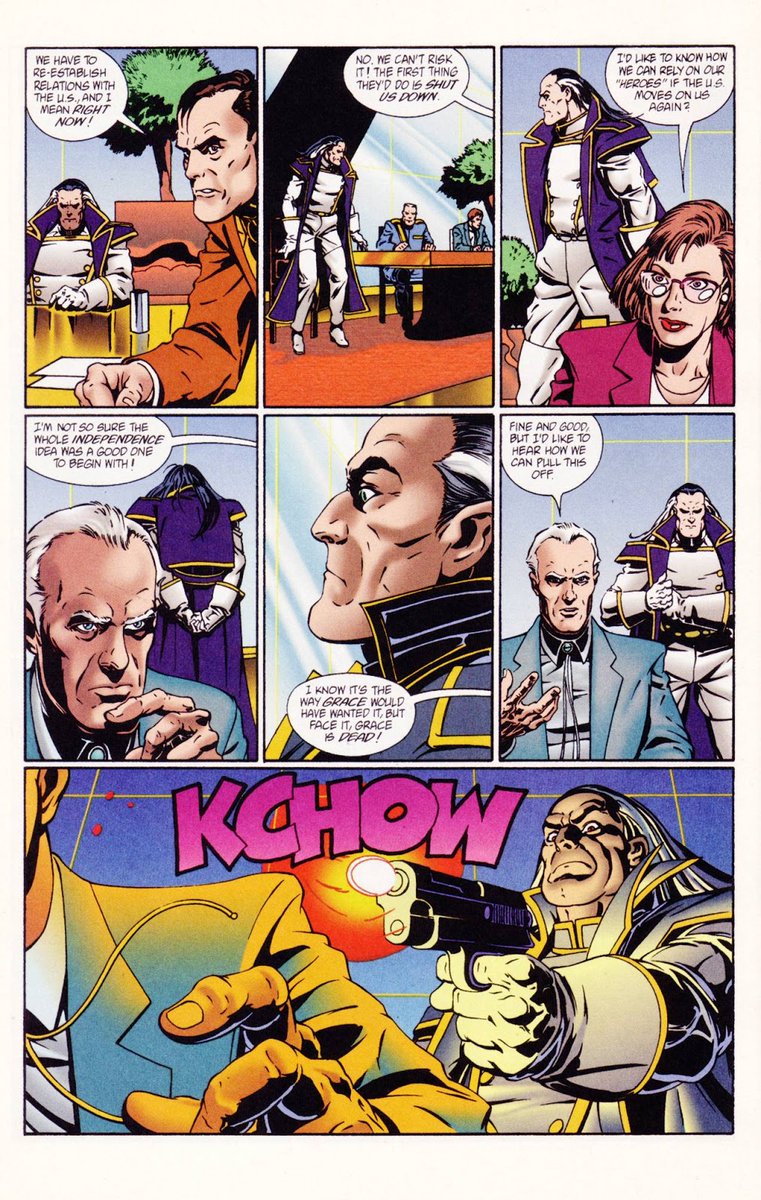
Law and his scientists construct a special gate at the entrance to Golden City through which any prospective citizen must pass. It replicates the Vortex effect, turning some into amazing superhumans and others into lumbering monsters which Law's men quickly execute. 

All is not lost however, despite Mecha being forced to flee, Ruby being abused by Law and the others forced to hide - Grace is alive! 
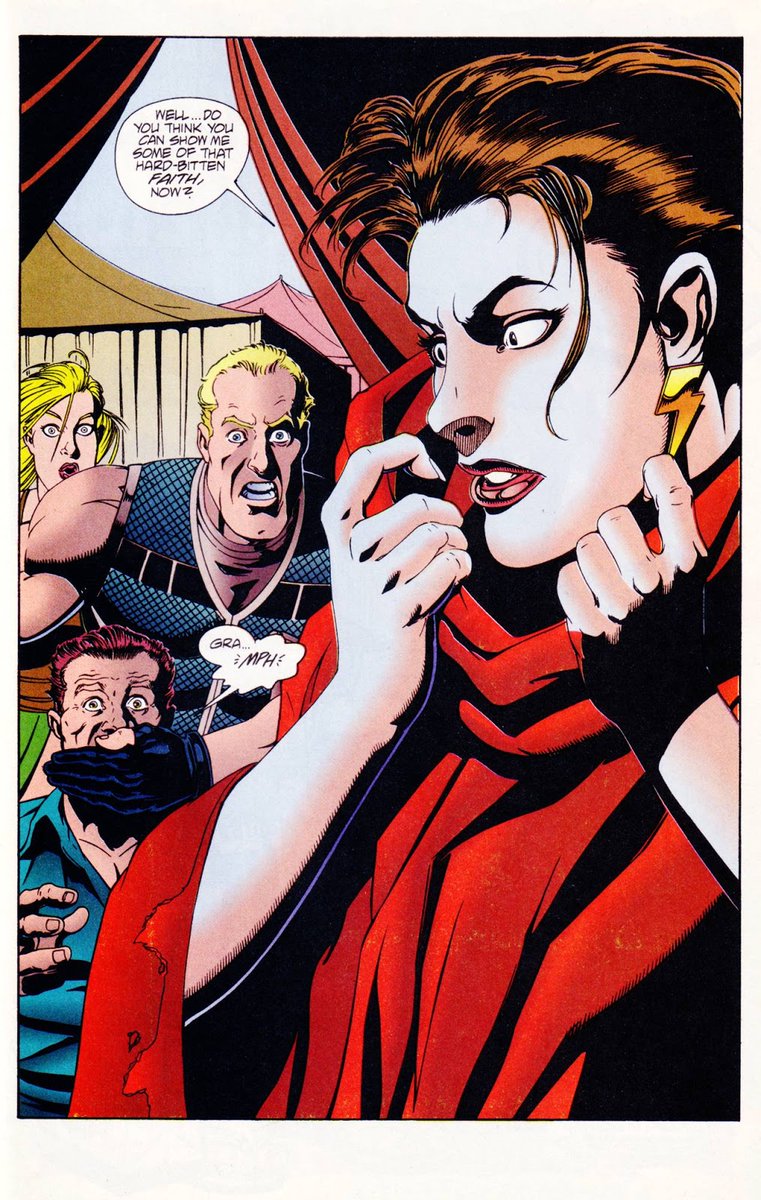
I am not going to spoiler how the sixth and final issue of Agents of Law ends because it's SO SILLY, so skip ahead if you want to find out for yourself.
The Predator is in Golden City and wants to fight the biggest, baddest enemy - Law!
The Predator is in Golden City and wants to fight the biggest, baddest enemy - Law!
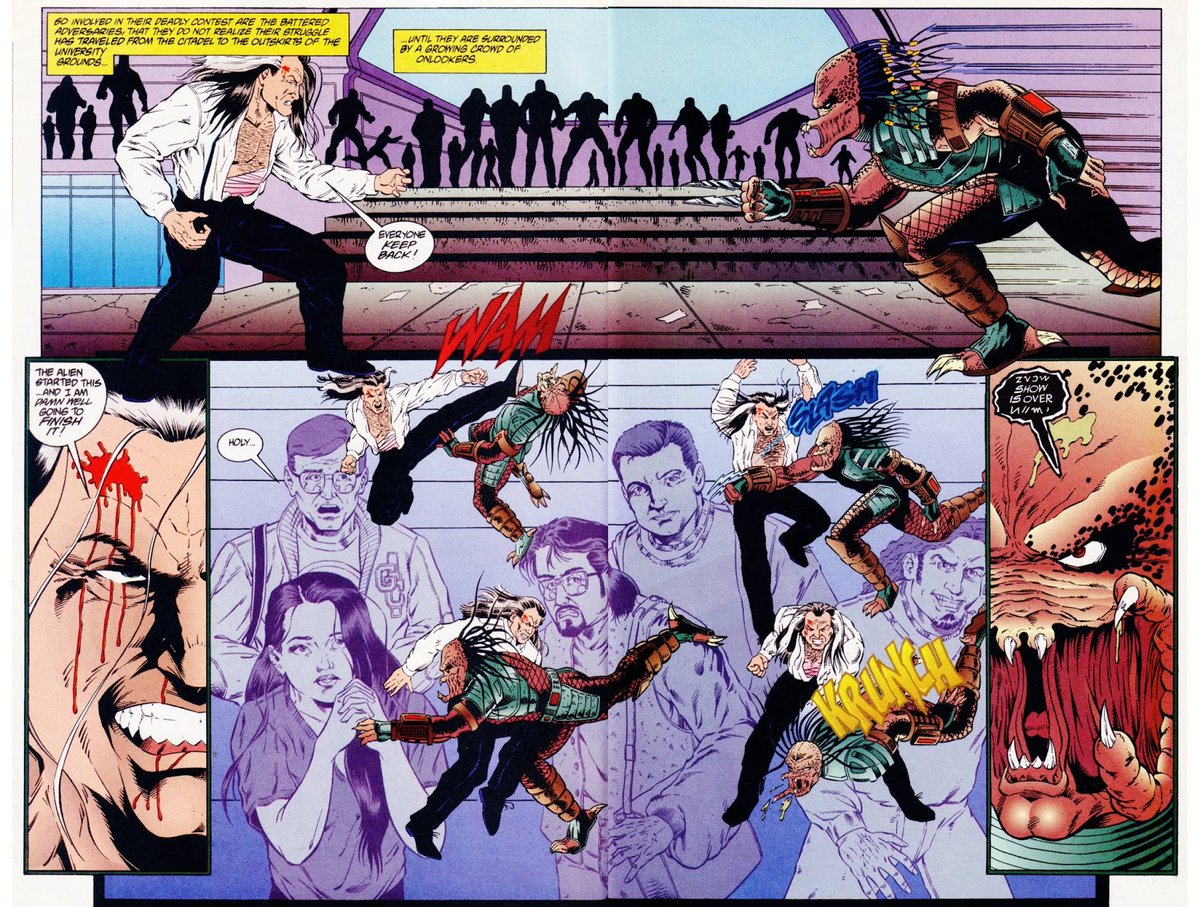
The deadly alien hunter and the most dangerous supervillain in the world clash across the city, wrecking buildings and causing destruction and death until they finally face off and... 
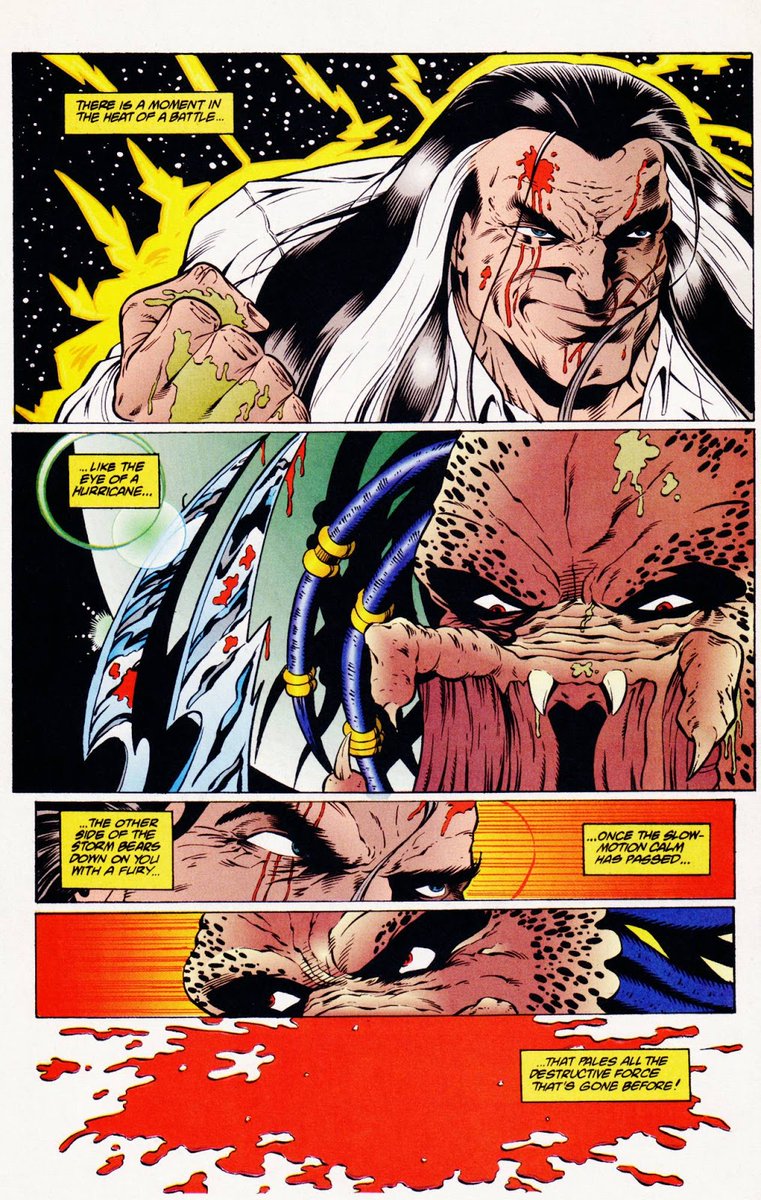
So that solved all Golden City's problems! Hooray! Grace and the Agents are free to rebuild their shattered home after the reign of terror. 
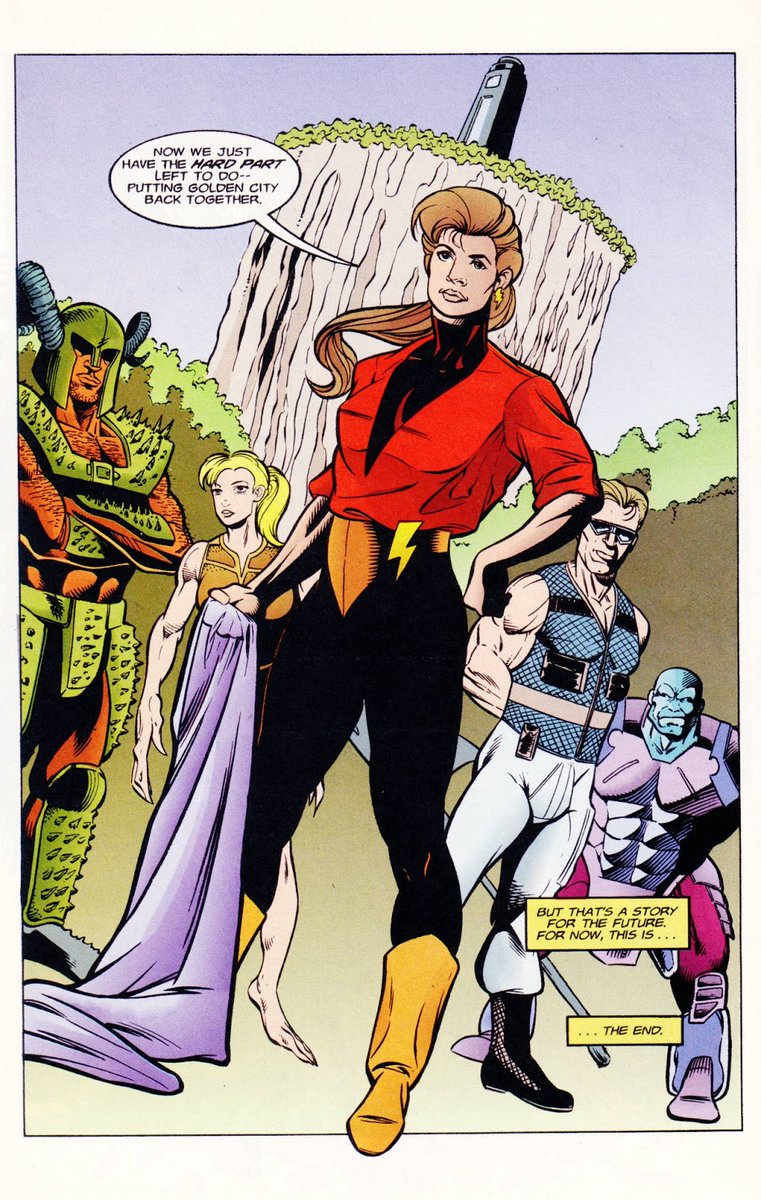
The series was canceled due to low sales. Initially Law was going to win, obviously, but at the last moment they just decided to redraw the story to have him die to the Predator instead. What a bizarre way to end a long story arc. 

Sorry, I should have said Agents of Law was the second-to-last new series of 1995. The actual last one was Motorhead which ran for six issues, written by D.G Chichester with Karl Waller and Tim Bradstreet on art. It also had Simon Bisley covers that looked like this! 

This series is honestly fun, with the Motor being portrayed as an actual character with little visualized panels to show what antics it is up to inside Karl's head. I can recommend it just for how weird it is. 
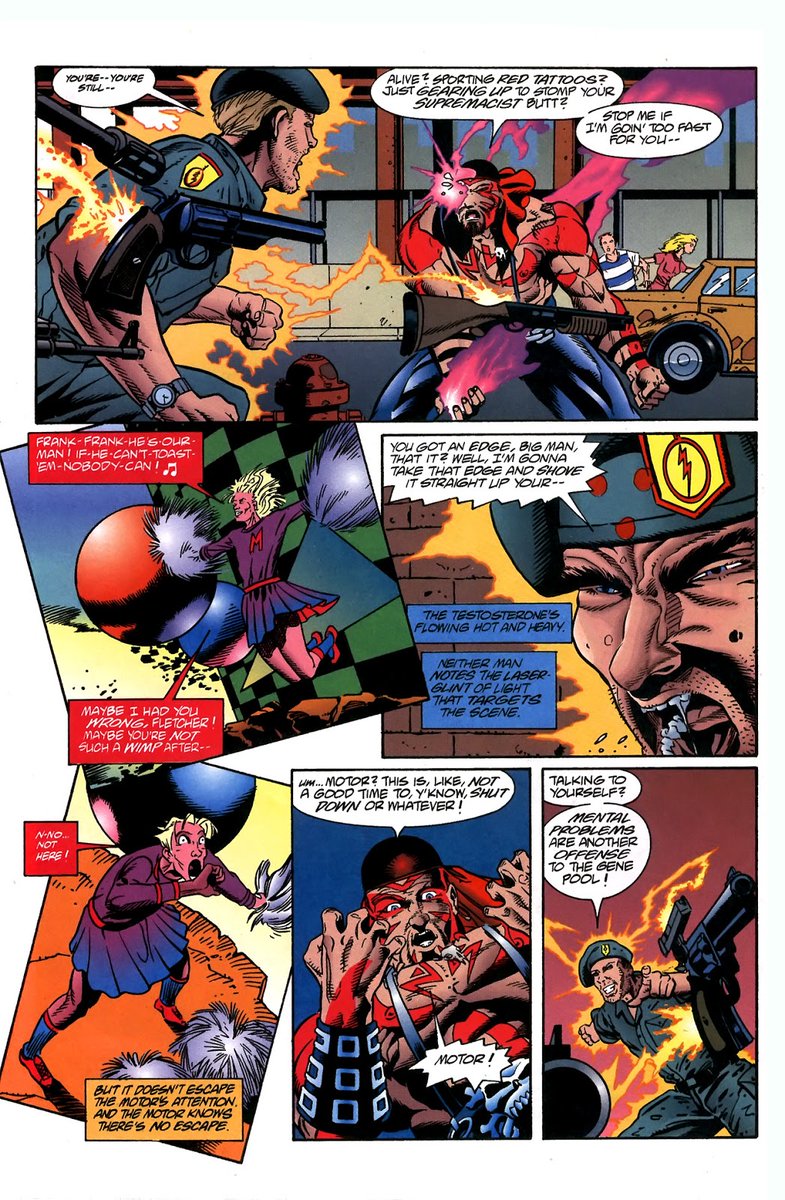
By 1996 the comics industry was in a state of utter disarray. With X ending early in the year the sole surviving title of the entire CGW publishing venture was Ghost and the year only saw a few scattered specials and limited series like Spirit Tiger/Motorhead and... oh yeah... 

Barb Wire is to date the only feature film based on one of these characters and changed the setting to the post-apocalyptic future of... 2017! The horror. Starring Baywatch's Pamela Anderson and some seriously bad writing, the movie was a box office flop. 

Barb DID have her own series briefly in 1994 and this is the origin of the "Don't call me babe" catchphrase, but otherwise the comic was very different from the movie. 

In 1996 however, Dark Horse not only released a movie adaption but also a four-issue mini called Ace of Spades where Barb suddenly looked a lot like Pamela Anderson. Argh, that pesky synergy! 
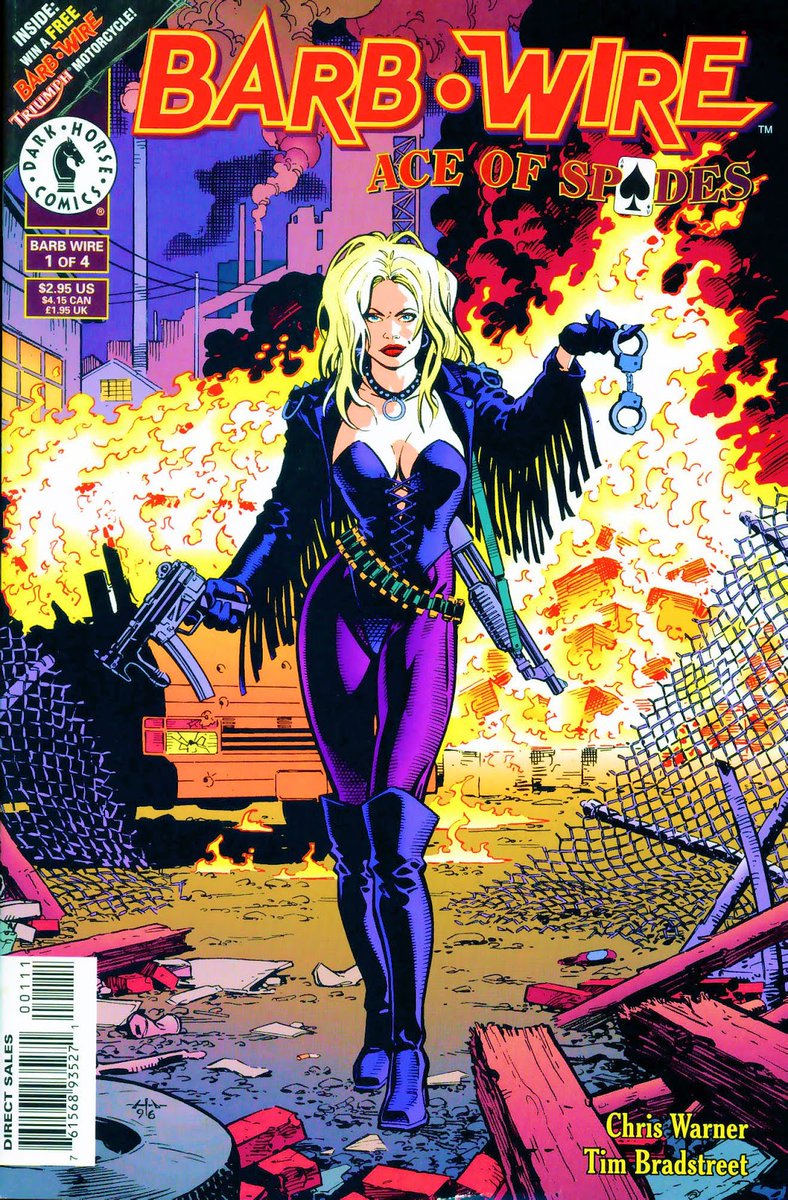
I think it's especially noticeable in this page but also the interior art. If the movie had been a hit, perhaps Barb would still look like this! But alas it was not, and she vanished into obscurity with the rest of the line. 

Ghost was the sole survivor (ironically) and continued to appear in new comics such as the Mignola-written Ghost/Hellboy with excellent Scott Benefiel art. 

In 1998 her title was relaunched as volume two, now written by Chris Warner with more Image-style art by Christian Zanier and Steve Moncuse. This series lasted until 2000 and MASSIVELY retconned Ghost's origins and personality, something which seems to have gone over badly. 

Though she managed to appear in a few more comics such as an unexpected crossover with Cassandra Cain in 2000, Ghost largely vanished after that, having survived the end of her universe by four years. 

The characters were mostly forgotten though they did sometimes appear in special occasions such as the Dark Horse 20th Anniversary special in 2006. 
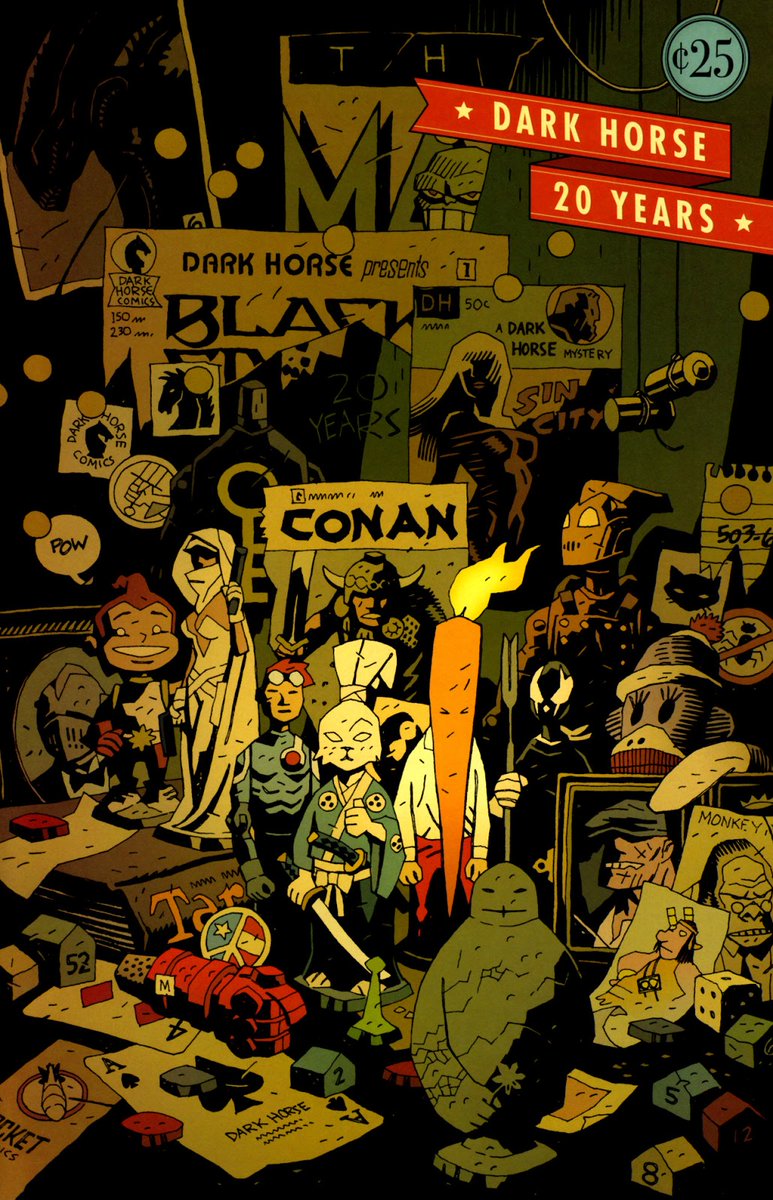
The last time the characters were seen was in the 2012-2015 period when many of them returned in reimagined forms under the "Project Black Sky" banner, a second attempt at a Dark Horse superhero universe. 

These comics mostly reimagined the characters from the ground up and didn't adhere to any previous canon but did still share a vague universe and occasionally crossed over. 

X, Barb Wire and Ghost all returned, with Ghost once more being the most successful, having several series before finally being canceled once more in 2015. 

As you can see, Comic's Greatest World was not a very impactful imprint. It existed for about three years and only spawned one series that lasted longer. Had it come out a few years earlier, perhaps it would have been a different story. But the glut and collapse in 1994-on meant 

...that even excellent series and publishers went under by the score. In that environment, it's a miracle that CGW managed to get out so many good series as it did. X and Ghost remain excellent reads to this day, and some of the others are quite fun too. 
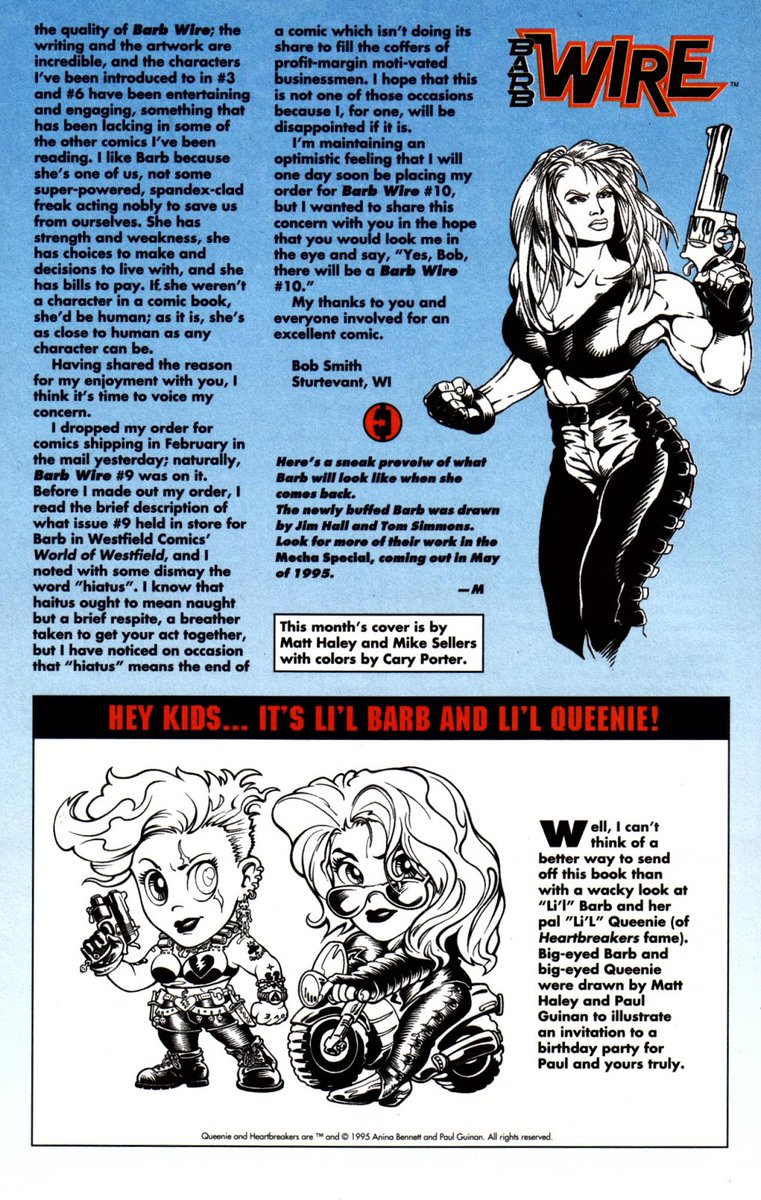
As for me? I only discovered this universe after it died. There was simply not enough money in my wallet at the time to check out yet another new setting and that really cuts to the bottom of it, doesn't it? 

I'm not gonna lie. I had a lot of fun reading through these comics again. This setting has a distinct atmosphere to it which is hard to describe. It's less traditional superheroes and more science fiction and fantasy concepts in a superhero mold, if that makes sense. 

Did you check any of these titles out? Do you have any favorites? Did I make any of you curious about this long-gone superhero setting?
Let me know!
Let me know!
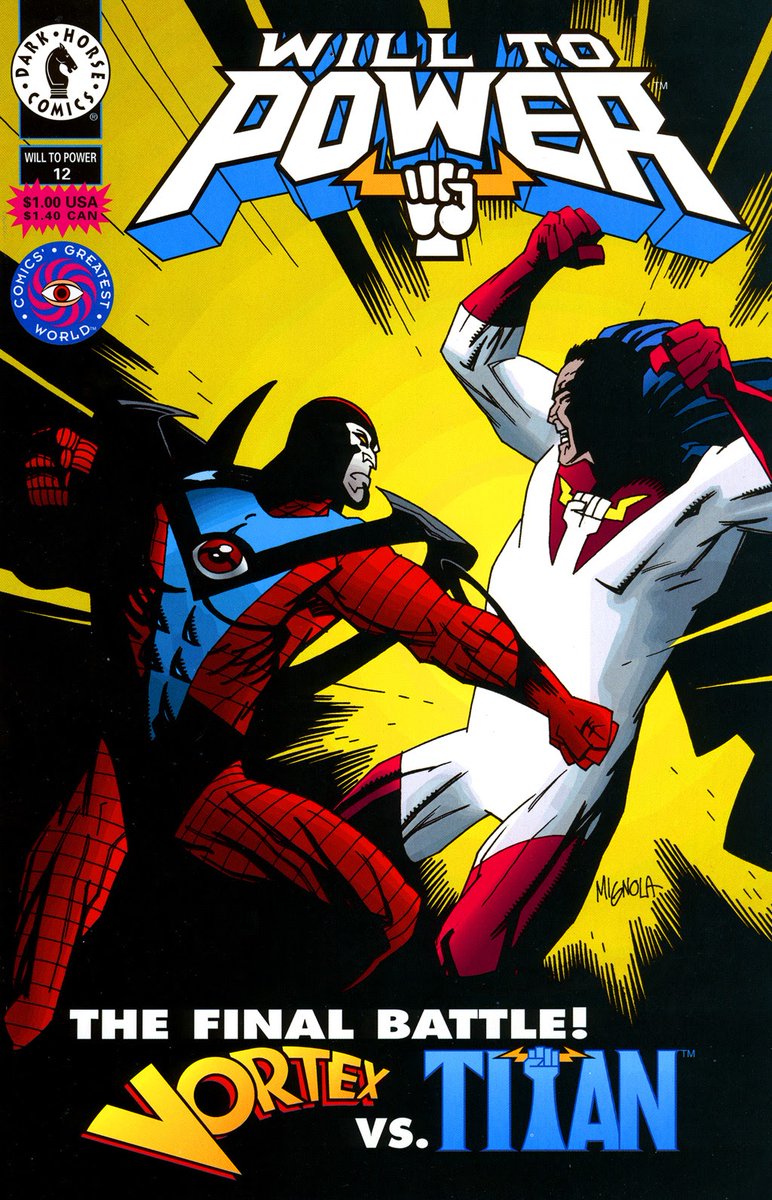
• • •
Missing some Tweet in this thread? You can try to
force a refresh


